
- Former Disneyland attractions
- Extinct Attractions

Adventure Thru Inner Space
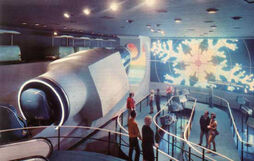
Adventure Thru Inner Space (formerly presented by Monsanto) or simply ATIS was a former attraction at Disneyland . It was located in Tomorrowland in the space where Star Tours: The Adventures Continue now resides. In it, guests were "shrunk" down to the size of a molecule, then to an atom, as they journeyed into the world of a snowflake during the winter.
The centerpiece of the attraction was Monsanto's Mighty Microscope —a giant microscope designed on a napkin by a Disney Imagineer . It was also one of the most advancing rides in technology as it was the first ride to utilize Omnimover vehicles known in the attraction as "Atommobiles". The attraction was narrated by Paul Frees , who also lent his voice to The Haunted Mansion , another Omnimover attraction that is still open to this day.
- 5 Vandalism
History [ ]
The idea of the attraction goes as far back as 1957 when Walt Disney introduced a concept for an atomic-themed exhibit in Tomorrowland on the Disneyland television show episode, Our Friend the Atom . Plans for the attraction were put on hold for the 1964 New York World's Fair . After the success of the fair, the atomic-themed attraction was green-lighted for the New Tomorrowland project. It would stand where the 20,000 Leagues Under the Sea and Monsanto Hall of Chemistry building stood.
This was the first ride with an Omnimover system. It opened as a free attraction, unlike most, but required a "C" ticket starting in 1972 . The original sponsor was Monsanto, which at the time was an agri-chemical company. Irene Kasmer, using Monsanto fabric, designed the uniforms of the attendants. In 1977 , Monsanto ended its sponsorship for the attraction. All visual and audio references were removed (except for the end line, "This is Monsanto") and the Monsanto Mighty Microscope's Monsanto logo was replaced with a logo that says "The Mighty Microscope".
The Monsanto posters advertising their products were replaced with Disneyland posters. All the items in the display area were taken away and the gift shop took over all the area of the old post-show area. Finally, the Monsanto "Fountain of Fashion" that dripped oil down strings tightened to it was replaced with a series of sculptures that looked like two plates put together with a snowflake on them. However, the shape of the old fountain/oil lamp was reused in the new sculpture. The attraction was finally closed in 1985 to be replaced with Star Tours in 1987.
A tribute to Adventure Thru Inner Space can be found in the Star Tours ride film. At the beginning of the ride, when the StarSpeeder is sent into a maintenance bay after going down the wrong path, the Mighty Microscope can be seen at the bottom of the maintenance area. This near-miss with the Mighty Microscope is featured in all versions of Star Tours. Star Tours itself was closed and replaced with Star Tours: The Adventures Continue at Disneyland and Disney's Hollywood Studios in 2011 . The Adventures Continue again pays tribute to Adventure Thru Inner Space, with the Mighty Microscope visible when escaping the under-construction Death Star above Geonosis .
Synopsis [ ]
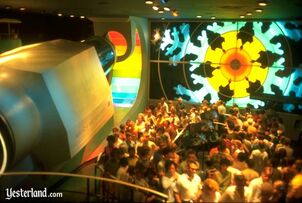
The Mighty Microscope
The attraction was designed to simulate humans shrinking to a size smaller than an atom (the "inner space"). As riders waited for their journey into the atom, they were able to see other riders entering one end of the Monsanto Mighty Microscope. The other end of the Monsanto Mighty Microscope had a glass tube in which miniaturized riders could be seen moving across. The microscope was aimed at a panel beyond which snow could be seen falling.
Upon boarding their 'Atommobiles', riders were greeted by the voice of an unseen scientist ( Paul Frees ) who explained, "I am the first person to make this fabulous journey. Suspended in the timelessness of inner space are the thought waves of my first impressions. They will be our only source of contact once you have passed beyond the limits of normal Mag-ni-fi-ca-tion."
The Atommobile entered the Monsanto Mighty Microscope and began to shake back and forth as the riders entered the darkness. As their vision returned, the riders saw giant snowflakes all around them, some still spinning as they fell. As they continued to shrink, the narrator exclaimed, "I am passing beyond the magnification limits of even the most powerful microscopes. These are snowflakes – and yet they seem to grow larger and larger. Or can I be shrinking – shrinking beyond the smallness of a tiny snowflake crystal? Indeed, I am becoming smaller and smaller!"
The snowflakes took on a crystalline form, eventually becoming large enough to cover the entire field of the riders' vision. Approaching the walls of ice crystals, the voice of the unseen scientist marveled, "These tiny bits of snowflake crystal tower above me – like an enormous wall of ice. Can I penetrate this gigantic prism? And yet, this wall of ice only seems smooth and solid. From this tiny viewpoint, I can see that nothing is solid, no matter how it appears." Indeed, it then became obvious to the Atommobile riders that the ice crystals were not solid, but a lattice-like structure that they pass through. "And still I continue to shrink! What compelling force draws me into this mysterious darkness—can this be the threshold of inner space?"
Next, we encountered a matrix of spheres appearing in columns and rows of infinite length. "What are these strange spheres? " asked the narrator. "Have I reached the universe of the molecule? Yes, these are water molecules – H2O. They vibrate in such an orderly pattern because this is water frozen into the solid state of matter."
As we continued to shrink, the molecules became larger and took on a peculiar Mickey Mouse shape . "These fuzzy spheres must be the atoms that make up the molecule – two hydrogen atoms bonded to a single oxygen atom. And I see that it's the orbiting electrons that give the atom its fuzzy appearance. And still I continue to shrink."
The scientist wondered, "Is it possible that I can enter the atom itself?" As the atommobile entered the atom, a storm of lights flashed past on all sides at impossible speeds. "Electrons are dashing about me – like so many fiery comets! Can I possibly survive?"
Suddenly the frenzy of the electrons passed, and the rider found him or herself in a large, empty space, surrounded in the distance by a sphere of slow-moving lights. "I have pierced the wall of the oxygen atom," continues the Narrator. "I am so infinitely small now that I can see millions of orbiting electrons. They appear like the Milky Way of our own solar system. This vast realm, THIS is the infinite universe within a tiny speck of snowflake crystal."
A large pulsating red ball could then be seen inside the atom. "And there is the nucleus of the atom! Do I dare explore the vastness of ITS inner space? No, I dare not go on. I must return to the realm of the molecule, before I go on shrinking...forever!"
The riders then began the return journey to full size, but were soon greeted with the sight of water molecules swirling rapidly. The scientist sees this as a discovery and says: "Ah, how strange! The molecules are so active now! They have become fluid – freed from their frozen state. That can only mean that the snowflake is melting!" Around us we saw molecules moving faster as their temperature increased. The molecules were depicted in green and yellow, with occasional star-shaped flashes representing evaporation.
"Yes, the snowflake has melted," intoned a scientist's voice (also Paul Frees), "But there is no cause for alarm. You are back on visual, and returning to your normal size." The riders could see evidence of the scientist's monitoring as they passed under a large microscope through which they can see his giant eye.
Having returned to normal size, the riders disembarked and passed by displays of Monsanto's advances in material science before exiting the attraction building.
Like many of the WED attractions of the 1960s including " It's A Small World ", the Carousel of Progress and the Enchanted Tiki Room , Walt Disney assigned his staff songwriters, the Sherman Brothers , the task of writing an opening and closing song for the Adventure Thru Inner Space attraction. That song was " Miracles From Molecules " and bridged the ride message of adventure with the Monsanto company's mission statement. A synthesized version of the song is used in the Tomorrowland background music loop. Most of the rest of the soundtrack of the ride was made by Buddy Baker .
- Xavier Atencio - Comchatman 2
- Paul Frees - Narrator
- Pete Renaday - Comchatman 1
Vandalism [ ]
Adventure Thru Inner Space had been known to get much more vandalism than any other ride in Disney's history. The eye at the end of the ride had to be encased in a protective glass layer to stop garbage, spit, and other annoyances. Set pieces were damaged or even removed due to these acts. Acts like this were so high that Disney developed a system called "Envelope of Protection." This utilized hidden cameras and forced the ride to close briefly to install these components.
- The Omnimover system used in this attraction would later be used for The Haunted Mansion .
- Rumors have sprung up that on board the ride, like on a lot of the dark rides, adults would perform sexual acts. They did this because they didn't know they were being monitored by personnel and were in complete darkness.
- It is speculated the original Mighty Microscope during deconstruction was detonated.
- Monsanto ended their sponsorship and didn't renew it in 1977, so all references in the ride script and sets were removed.
- Four tributes to Adventure Thru Inner Space exist in Star Tours :
- The first queue line segment is the same from its days as Adventure Thru Inner Space .
- An Atommobile from the glass Mighty Microscope tube has been sighted in one of the overhead bins in the Droid Room.
- The Mighty Microscope can be seen in the Maintenance Area in the ride movie on the bottom-right hand side, right before the Starspeeder heads into space.
- The comets are based loosely on the dancing snowflakes.
- Additionally, the new Star Tours features the Mighty Microscope in a corridor on the left hand side of the screen before the StarSpeeder 1000 leaves the unfinished Death Star through a docking bay.
- The Omnimovers from Adventure Thru Inner Space were sent to a landfill in Mexico, but at least two have been known to survive. One is on display in the Disneyana museum at Disneyland (open to Cast Members only). The others are in the hands of collectors.
- A clone of the attraction was in the works for the cancelled WestCOT at Disneyland. In addition to the shrinking to the size of a molecule, you would grow to see the world around you.
- Several references to the attraction appear in the Mickey Mouse episode " Down the Hatch " with the short's credits featuring Donald Duck singing Miracles From Molecules .
- There is a fanmade Adventure Thru Inner Space virtual ride through for sale on Blu-ray and Youtube at https://www.youtube.com/watch?v=KA3uFkF1A9o .
- 2 The Emotions

- Ultimate Fan Event
- News and Events
- Disney A TO Z
- WALT DISNEY ARCHIVES
- VIDEO & PHOTO GALLERIES
- Redeem Gift Membership
- Redeem Gold Affiliate
- Gift Gold Membership
- 2024 Gold Collector Set
- Publication
- Disney Parks
- Disney Princess
- Company History
- About Walt Disney
- Ask Archives
- Disney A to Z
- D23 Exclusive
- D23 Inside Disney Podcast
- Just For Fun
- Videos & Photos
- Recipe Collection

Did You Know?: 8 Mighty Fine Facts About Adventure Thru Inner Space
By Greg Ehrbar
Certain past Disneyland attractions stir instant memories for guests fortunate enough to have experienced them—and also inspire the imaginations of those who wish they could have enjoyed them.
Topping many a list is Adventure Thru Inner Space , which opened August 5, 1967. This ingenious attraction took guests through a Mighty Microscope to become tiny enough to enter the molecules of a snowflake, all in a style and manner that was as mind-twisting and unsettling as it was enlightening and optimistic. Here are some little tiny jots and tittles about the Disneyland classic:
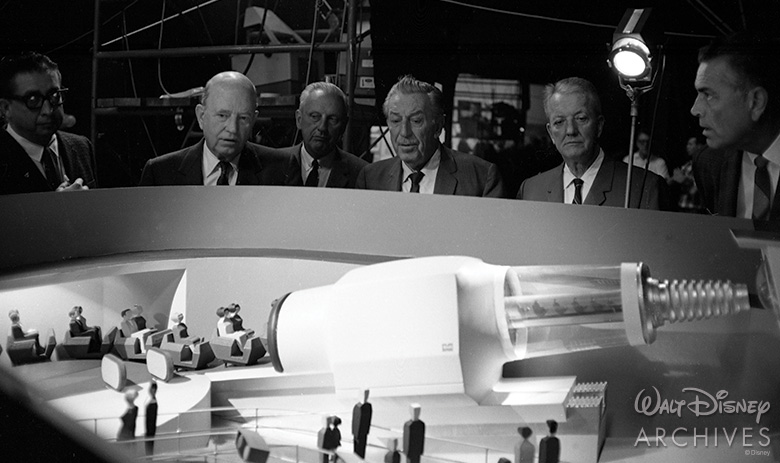
1. It introduced the Omnimover system, which was all started by a candied apple. Imagineer Bob Gurr first dreamed up the idea while brainstorming with Imagineer John Hench . “John wanted to know why we couldn’t tell a story by allowing the moving guests to go up and down steep hills and look in any direction, even behind them,” Bob recalled. “I casually picked up a toy candied apple on a stick from his desk, twirled it in the air and said, ‘Like this?’ ‘Yeah, like that.’” The ride vehicles were dubbed “Atomobiles.” The Omnimover system would later be used to transport guests through the Haunted Mansion and other Disney parks favorites.

2. It was going to be part of Tomorrowland 10 years earlier. “Science Land”—also known as “Adventures in Science”—was to be built near the present site of Space Mountain . The “Micro-World” attraction would take guests into a drop of water. “The ride vehicles were originally shaped like protozoa,” explained Disney author and historian Todd James Pierce from the Disney History Institute. “The first piece of Micro World concept art released (dated 1957) looks very close to the Inner Space pre-show area.”
3. It could be a bit scary. Imagineer Alan Coats—son of Imagineer Claude Coats , the show designer of Adventure Thru Inner Space —shared this letter a man wrote to Walt Disney Archives founder Dave Smith from the Spring 2001 issue of Disney Magazine : “I was so terrified by the Adventure Thru Inner Space ride that I snuggled tight to my mom and wouldn’t open my eyes. I did open my eyes on a trip about two years later and was fascinated by the ride.”
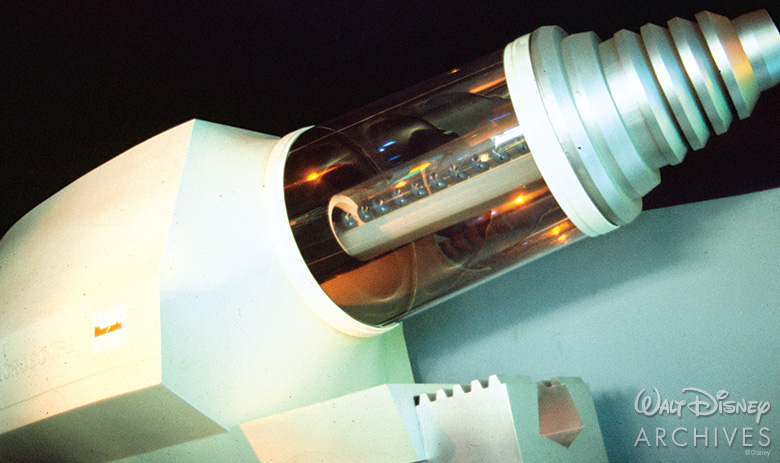
4. The Mighty Microscope was wondrous—and intimidating. Designed by Imagineer George McGinnis, this mammoth device caused many a youngster (and adult) to quiver because one could see other guests aboard their Atomobiles as they went inside, then a few feet up, other guests who appeared to have shrunk in size before entering the snowflake!
5. Paul Frees gave one of his finest—and most unnerving—performances . It was a role he was destined for since being heard in such science fiction films as The Time Machine and recordings like Exploring the Unknown . It is also one of the few, if only, attractions narrated in first person. “It was one of my all-time favorites,” says Paul’s son Fred, an accomplished voice actor himself. “Partly because it was voiced by dad and partly because I liked science.” The attraction’s writer, Imagineer and Disney Legend X Atencio —whose credits also include the Haunted Mansion and Pirates of the Caribbean —and Pete Renoudet, who plays Henry in Country Bear Jamboree , also provided voices in the preshow area.
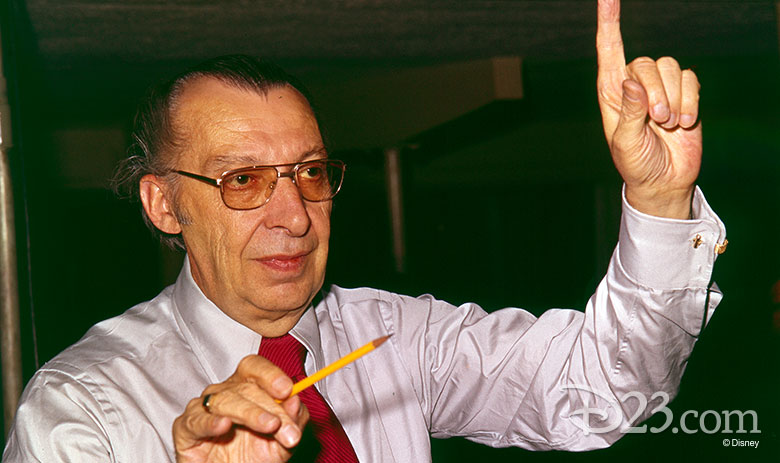
6. Buddy Baker (pictured above) created his most unusual, avant-garde score. “With 45 musicians, on May 31, 1967, Baker recorded some 47 different pieces of music,” wrote Disney artist and historian Stacia Martin in The Sounds of Disneyland . “No one before had given musical voice to things like the internal vibrations of a water molecule (bass marimba) or the random frenzy of whirling molecules (electronic flute).” In addition, there was a happy, peppy Sherman brothers tune called “Miracles from Molecules.”
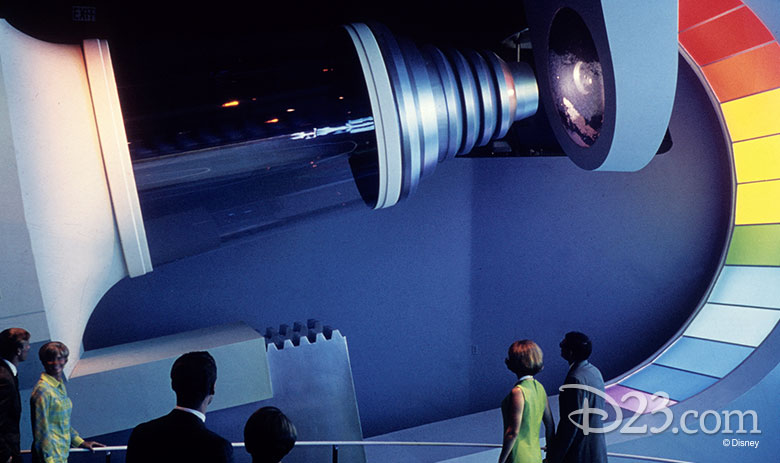
7. It was pre-CG and lasers, but it continues to inspire today’s filmmakers. “You weren’t really all that concerned about how things were done because you were inside the atom, for gosh sakes!” says Don Hahn, producer of Beauty and the Beast . “And it wasn’t just about exploring a snowflake, it was about ‘the future’ and that was why it was in such a key location in Tomorrowland. It had the same magic, fantasy, and promise to it as going to the moon. It was such a special ride.”
8. References to the attraction have been featured in its replacement, Star Tours . After Star Tours replaced Adventure Thru Inner Space (which closed in 1985), guests could find tributes to the original attraction throughout the experience. A keen eye could spot a miniature Atomobile among the scraps passing overhead in the Droidnostics Center and also catch a glimpse of the Mighty Microscope in the lower right view (when the StarSpeeder exited the hangar bay.) Today, in Star Tours – The Adventures Continue , guests can look for the Mighty Microscope as their StarSpeeder exits a tunnel in the Death Star!
Benefits of Meditation
Learn meditation, meditation faqs, spirituality, finding your true purpose, spiritual awareness, spiritual growth, spiritual master, healthy living, benefits of vegetarian diet, vegetarian recipes.
- Sant Rajinder Singh Ji Maharaj
Our Organization
International meditation center, programs & events, online programs, global meditation in place, learn to meditate, personal transformation through meditation, spiritual awareness series, detox the mind, meditation as medication for the soul, divine beauty – women's meditation retreat (online events), learn to meditate (spanish), women's meditation retreat (spanish), in-person programs, sant rajinder singh ji maharaj programs, science of spirituality programs, spiritual talks, spiritual quotes, guest author articles.
- Find Center

Journey into Inner Space through Meditation
Aug 1, 2021
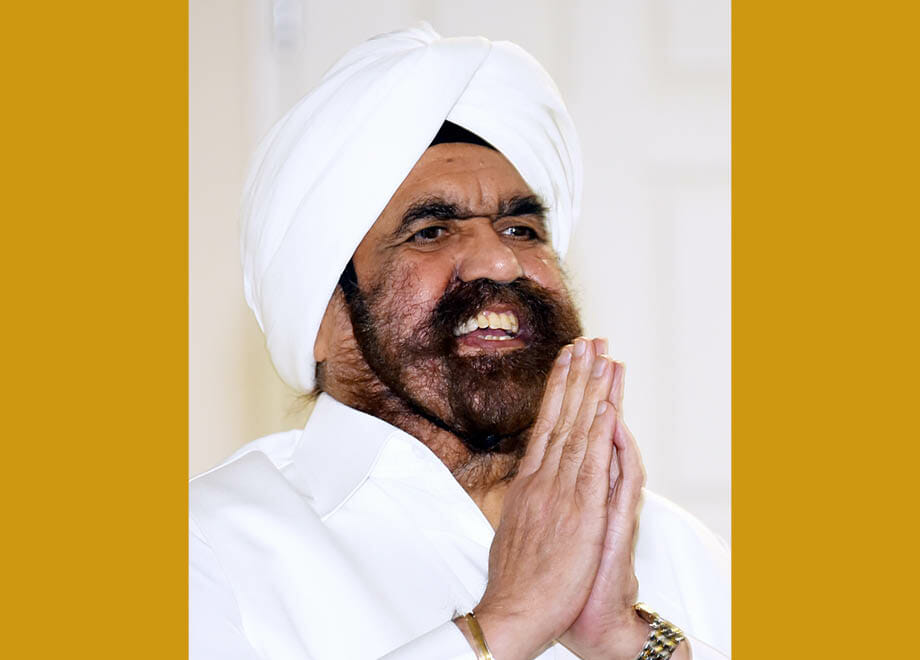
The month of July saw the launch of not one but two passenger spaceflights taking ordinary inhabitants of Earth to the threshold of space, marking the beginning of a new age of space tourism and exploration. In his Sunday spiritual discourse, Sant Rajinder Singh Ji Maharaj spoke of yet another type of exploration. This one serves to broaden our horizons and leads to a profound transformation: the journey to inner space—the vast worlds that exist beyond our physical consciousness.
Unlike the journey into outer space, the journey into inner space does not require any material investment—no launching pad, no spaceship, no focus on monitoring and mapping from takeoff to landing. It also does not require us to attain a certain level of physical fitness. The spiritual Master explained that inner space lies within, and as human beings, we each have all that is needed to explore it.
We embark on the journey into inner space through a process called meditation. Our launching pad is the spiritual or third eye, the gateway into the inner spiritual regions. What travels into the inner worlds is not our body but our true essence, which is spirit. We travel into inner space by withdrawing our attention from the outer world and focusing it on the inner worlds. As we journey within, we connect with God’s love and Light. Imbued in this divine love, we awaken to the reality of our existence, and we are transformed. We become more loving, more caring, more peaceful, and embrace the oneness of all life. Step by step, this inner journey culminates in the union of our soul with God. It all begins with meditation.
Recent Posts
- Toronto Tour 2024
- NJ Tour Hindi 2024
- NJ Tour 2024
- The Oneness of All Life
- The Power of Love and Kindness
- The Power of Loving-kindness
- Bahrain Tour 2024
- Dubai Tour 2024
- Boost Your Meditation Time Step by Step
- Nonviolence in Thought
- True Valentine’s Day is Between the Soul and God
- Experience God Within
- Trust in God
- What is Spiritual Development
- What is Humility?
- February 2024
- January 2024
- December 2023
- November 2023
- October 2023
- September 2023
- August 2023
- January 2023
- February 2022
- January 2022
- December 2021
- November 2021
- October 2021
- September 2021
- February 2021
- January 2021
- December 2020
- November 2020
- October 2020
- September 2020
- August 2020
- February 2020
- January 2020
- December 2019
- November 2019
- October 2019
- September 2019
- August 2019
- January 2019
- December 2018
- November 2018
- September 2018
Privacy Overview
Request URL: https://www.sos.org/recent-news/journey-into-inner-space-through-meditation/
Please complete all * marked fields. Thank You!
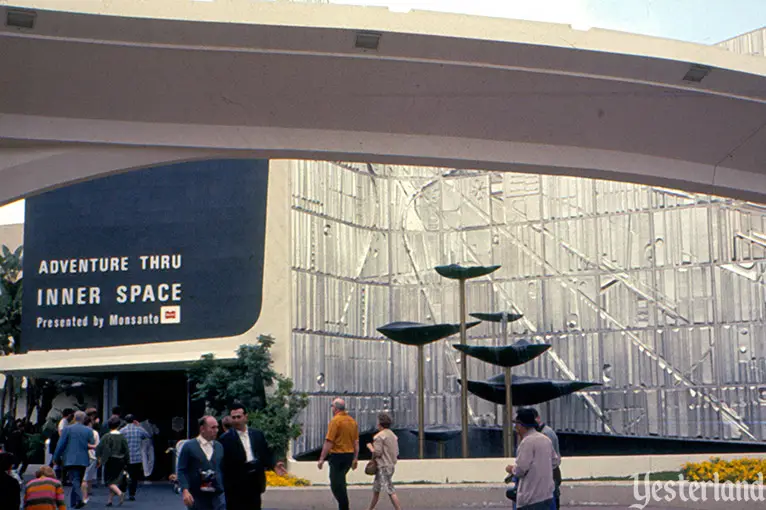
Photo by Roger J. Runck, 1968, courtesy of Robin Runck.
Sure, you expect Tomorrowland to celebrate Outer Space. But Yester-Tomorrowland also lets you travel to Inner Space.
Prepare to be “miniaturized” for a journey into the world of molecules and atoms.

Photo by Werner Weiss, 1969
The queue, setting the stage for what to expect
While waiting in the queue, you see other guests in blue pods enter one end of the Mighty Microscope, appear near the opposite end only a few inches tall, and finally disappear entirely.
The screaming you hear is not coming from the ride. It’s coming from a child terrified at the prospect of being shrunken down and then vaporized.
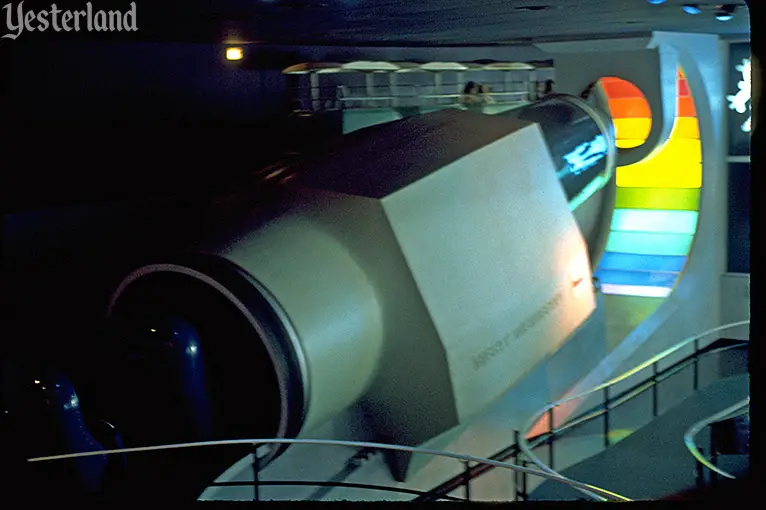
Photo by Dennis Caswell, 1972
PeopleMover train passing behind Monsanto’s Mighty Microscope
Now it’s your turn. Step on to the moving platform and board your Atomobile—similar to a Haunted Mansion Doom Buggy—traveling at the same speed as the platform.
After passing through the Mighty Microscope, you’re shot into a flurry of giant snowflakes. Actually, they’re normal-sized snowflakes, but you’re really tiny. At least that’s the conceit here.
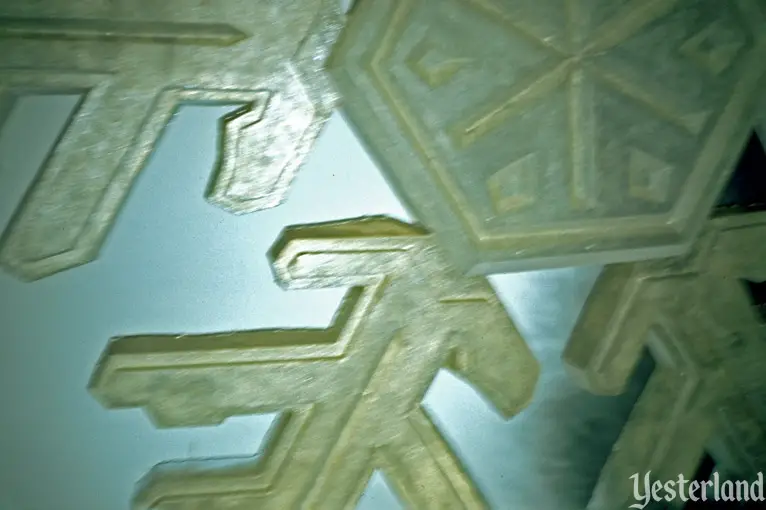
Photo by Dennis Caswell, 1971
As they say somewhere else , “You are not the first to pass this way.” Someone has made this journey before you. Sounding suspiciously like the Ghost Host at the Haunted Mansion, his thought waves emerge as a voice from speakers in your Atomobile:
“I am the first person to make this fabulous journey. Suspended in the timelessness of inner space are the thought waves of my first impressions. They will be our only source of contact, once you have passed beyond the limits of normal magnification.
“I am passing beyond the magnification limits of even the most powerful microscope. These are snowflakes, and yet they seem to grow larger and larger! Or can I be shrinking, shrinking beyond the smallness of a tiny snowflake crystal? Indeed, I am becoming smaller and smaller!”
As you continue to shrink, you see a neatly arranged array of fuzzy spheres, each with two smaller fuzzy spheres. These are H 2 O molecules.
“And still I continue to shrink! Is it possible that I can enter the atom itself?
Yes, it’s possible. In fact, you’ve now done so.
“Electrons are dashing about me, like so many fiery comets. Can I possibly survive?
“I have pierced the wall of the oxygen atom! I am so infinitely small now that I can see millions of orbiting electrons. They appear like the milky way of our own solar system. This vast realm—this is the infinite universe within a tiny speck of snowflake crystal!”
Suddenly, there’s a pulsating red sphere directly in front of you.
“And there is the nucleus of the atom! Do I dare explore the vastness of its inner space? No, I dare not go on! I must return to the realm of the molecule, before I go on shrinking forever! ”
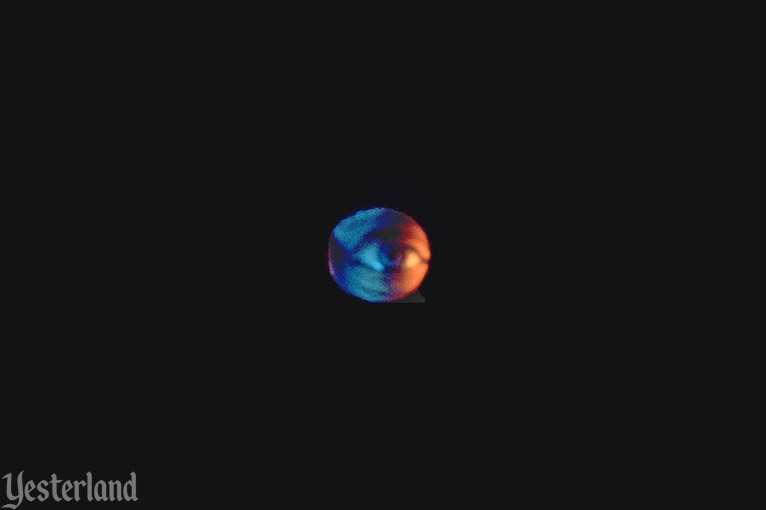
Always watching
As the snowflake begins to melt, you begin to return to normal size. You’re back on visual. Look up! A Monsanto scientist is watching you through a microscope.
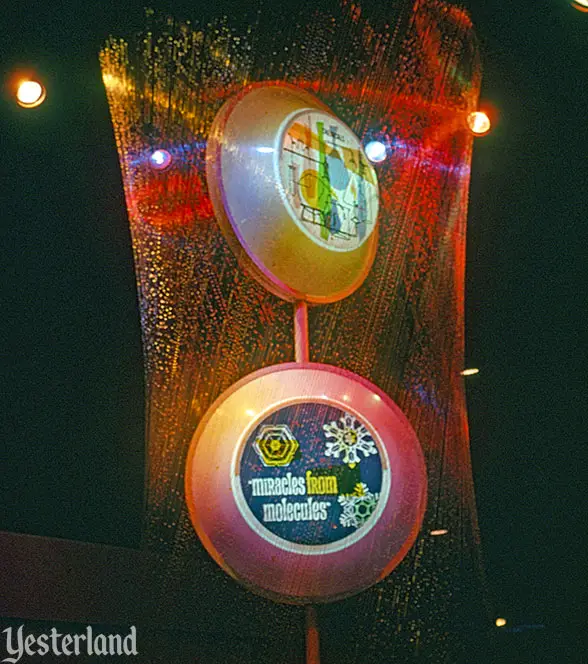
Photo by Marion Caswell, 1975, courtesy Dennis Caswell
“Miracles from Molecules”
Your ride ends at Monsanto’s Fountain of Fashion. Mineral oil runs down nylon strands that surround a mannequin wearing the latest fashion crafted from Monsanto synthetic fibers. Or the nylon strands surround round signs with Mid-Century Modern graphics.
A bouncy theme song is playing. It’s “Miracles from Molecules” by brothers Robert B. Sherman and Richard M. Sherman—the team responsible for the “it’s a small world” song.
Miracles from molecules, around us everywhere. There are miracles from molecules, in the earth, the sea, the air. Now men with dreams are furthering what nature first began: Making modern miracles, from molecules, for man.
Every atom is a world, an infinity unfurled, A world of inner space without an end, A world of mystery, of endless energy, With treasures more than man can ever spend.
Miracles from molecules are dawning every day. Discoveries for happiness, in a fabulous array. A never-ending search is on, by men who dare and plan. Making modern miracles, from molecules, for man.
Making modern miracles, from molecules, for man!
Enjoy the “This is Monsanto” displays. Now head directly into the Character Shop next door.
Adventure Thru Inner Space opened at Disneyland on August 5, 1967.
The ride was part of New Tomorrowland, the spectacular upgrade of the land that had not lived up to its potential when Disneyland opened 12 years earlier. Sadly, Walt Disney never saw the completion of New Tomorrowland, having died December 15, 1966.
Adventure Thru Inner Space occupied the space that previously housed the 20,000 Leagues Under the Sea walk-through and the Monsanto Hall of Chemistry .
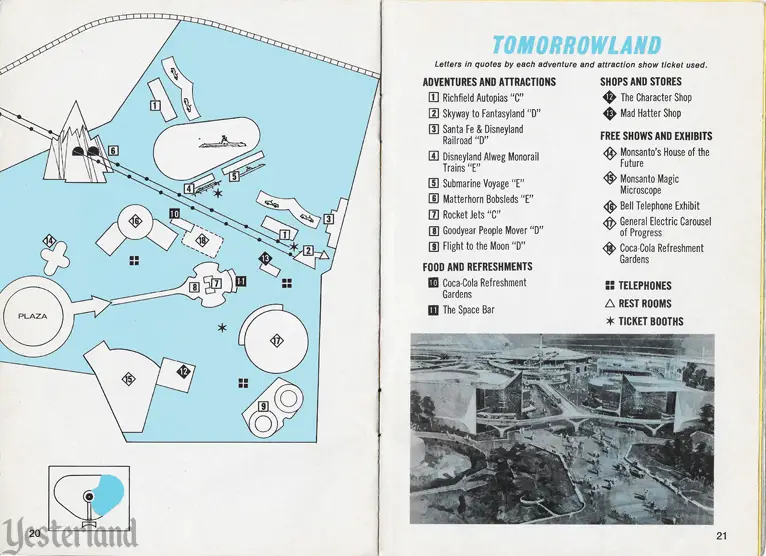
© 1967 Walt Disney Productions
Two pages from Your Guide to Disneyland , Summer 1967
New Tomorrowland had six major new attractions. Four were open on or before July 2, 1967. Adventure Thru Inner Space was delayed, but it wasn’t last. Flight to the Moon opened a week later on August 12, 1967.
Guests visiting that summer received Guide Books indicating Monsanto Magic Microscope as the attraction name. And Bell Telephone Circle-Vision 360 was listed simply as Bell Telephone Exhibit . Disneyland is more careful with nomenclature these days.
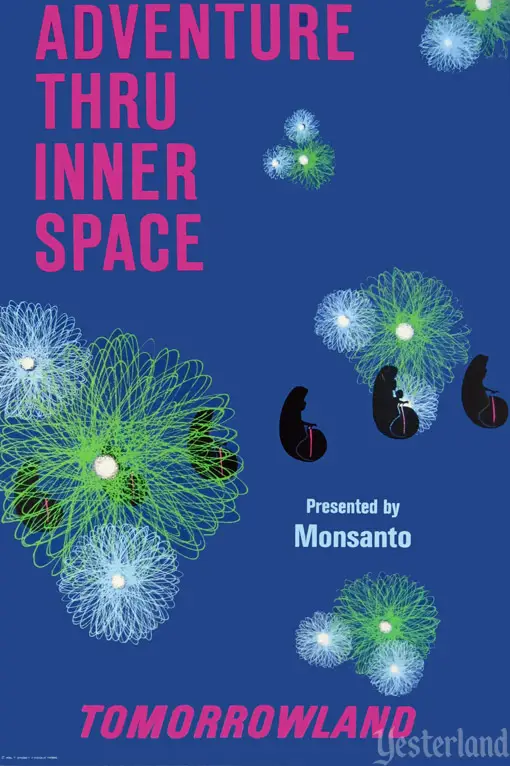
© Walt Disney Productions
Attraction poster with Atomobiles passing giant H 2 O molecules
The Atomobiles were revolutionary. The patented OmniMover ride system provided high capacity through continuous loading and the ability to direct guests’ attention to specific parts of a show scene, while providing an experience that came across as personal. The Haunted Mansion opened two years later with the same ride system—and the same narrator (Paul Frees). Disney continues to use variations of the OmniMover system.
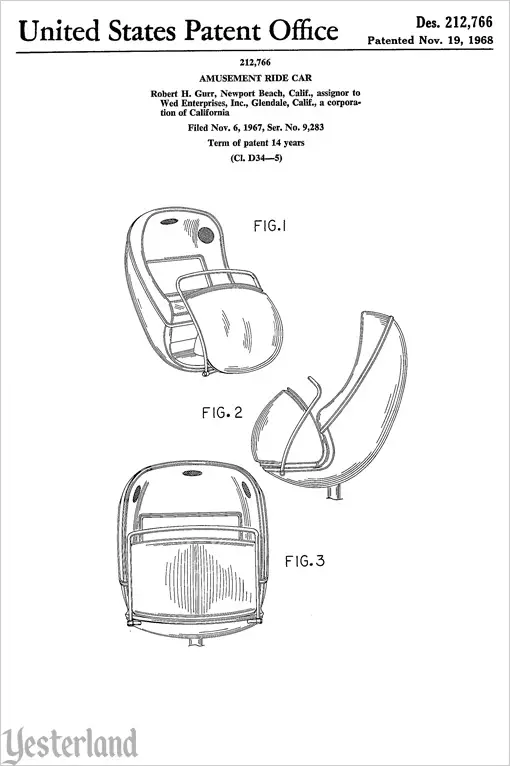
Source: United States Patent and Trademark Office
U.S. Patent Office document D212766
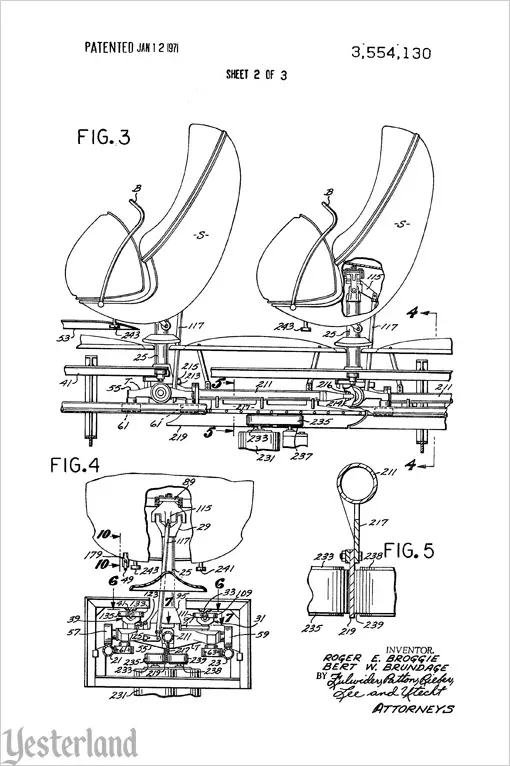
A drawing from U.S. Patent 003554130
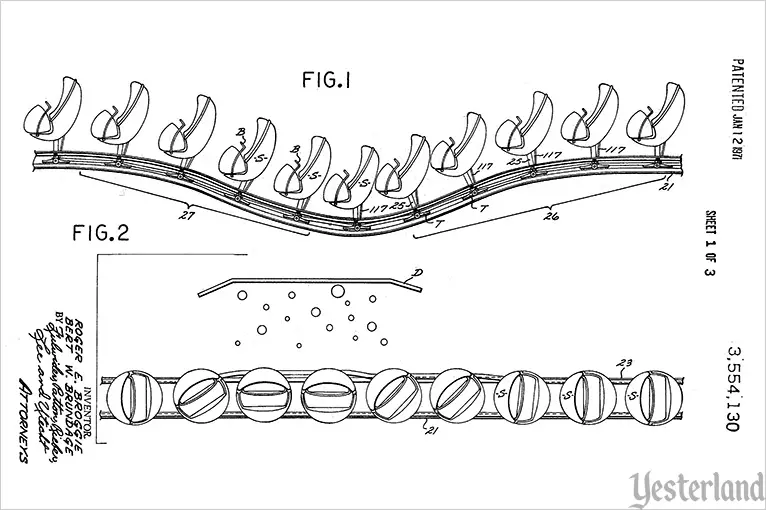
Another drawing from U.S. Patent 003554130
In the era of attraction tickets, Adventure Thru Inner Space had the distinction of being an actual ride (not an exhibit or show) that didn’t require a ticket. Initially, kids would ride it over and over—because they could. Disneyland solved this by adding a special Inner Space coupon to ticket books and general admissions for juniors (12 though 17) and children (3 thru 11), so it was still free for kids, but only once per park visit.
In 1972, Adventure Thru Inner Space became a ticketed attraction requiring a “C” ticket. Monsanto dropped its sponsorship in 1977, but the attraction continued to operate—just with references to Monsanto scraped from it.
Adventure Thru Inner Space closed September 2, 1985, after a run of 18 years. The space was needed for Star Tours (now Star Tours – The Adventures Continue ).
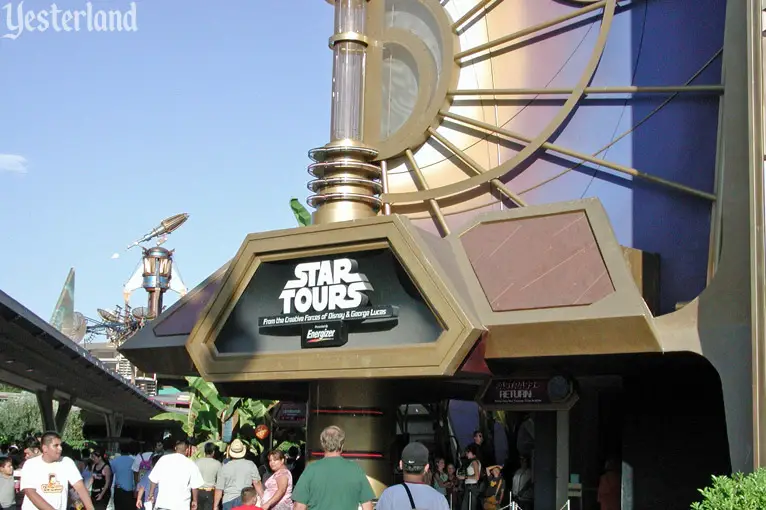
Photo by Werner Weiss, 2004
Star Tours , as it looked in 2004

Photo by Allen Huffman, 2017
Star Tours , still with the sculpted exterior wall from Adventure Thru Inner Space
Both versions of Star Tours include a tribute to the Disneyland attraction they replaced. In the simulator film, just before the StarSpeeder emerges from the maintenance bay into space, the Mighty Microscope can be seen at the right.
Click here to post comments at MiceChat about this article.
© 1995-2019 Werner Weiss — Disclaimers, Copyright, and Trademarks
Updated November 1, 2019.

Themed Ideas, Artwork, Histories, and Storytelling

Adventure Thru Inner Space: The View From Within Disneyland’s Molecular Mid-Century Dark Ride
“Suspended in the timelessness of inner space are the thoughtwaves of my first impressions. They will be our only source of contact once you have passed beyond the limits of normal MAG-NI-FI-CA-TION!”
Park Lore was established to preserve the timeless tales of lost masterpiece rides for future generations. We’ve explored fan-favorites like 20,000 Leagues Under the Sea , Alien Encounter , Mr. Toad’s Wild Ride , TOMB RAIDER: The Ride , The Peoplemover , Soarin’ Over California , and so many more . All along we’ve asked for your comments and memories to help us save these attractions forever and explore their in-depth stories.
Now, we turn to a Tomorrowland favorite, and an almost-unbelievable journey down to the size of an atom. A classic dark ride that kick-started the intellectual wonder of a generation, Adventure Thru Inner Space was an early precursor to the optimistic, inspirational, enigmatic dark rides that populated EPCOT Center when it opened. This once-headlining dark ride debuted brand new technologies still in use today, and is still remembered as an icon of Disneyland’s most well-loved era: Tomorrowland 1967.
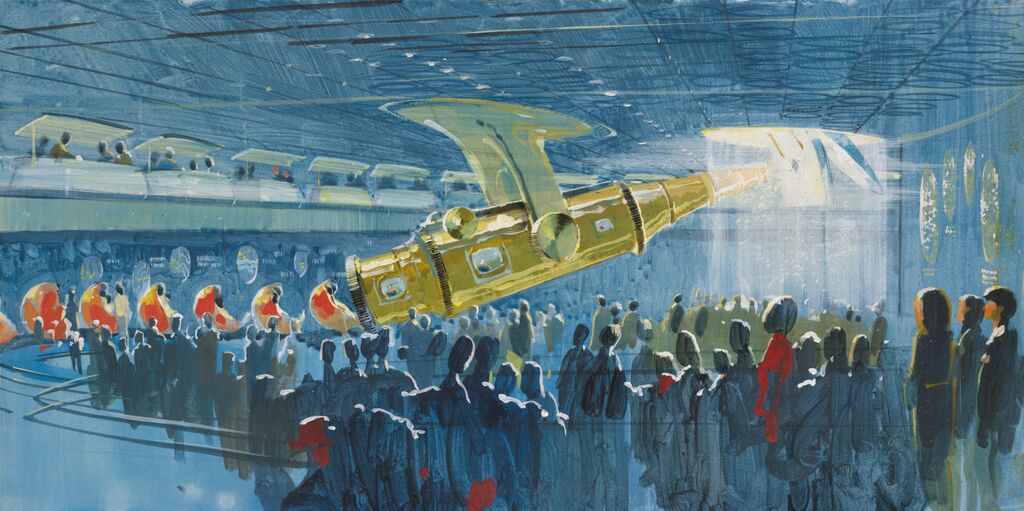
A stunning journey into the retro-wonders of atomic energy and structure, this educational dark ride left riders speechless. So what did guests find in the magnificent reaches of the microscopic world? We’re about to find out. Prepare for magnification!
And before we head off, remember that you can unlock rare concept art and audio streams in this story, access over 100 Extra Features , and recieve an annual Membership card and postcard art set in the mail by supporting this clickbait-free, in-depth, ad-free theme park storytelling site for as little as $2 / month! Become a Park Lore Member to join the story! Until then, let’s start at the beginning…
Old Tomorrowland (1955 – 1959)
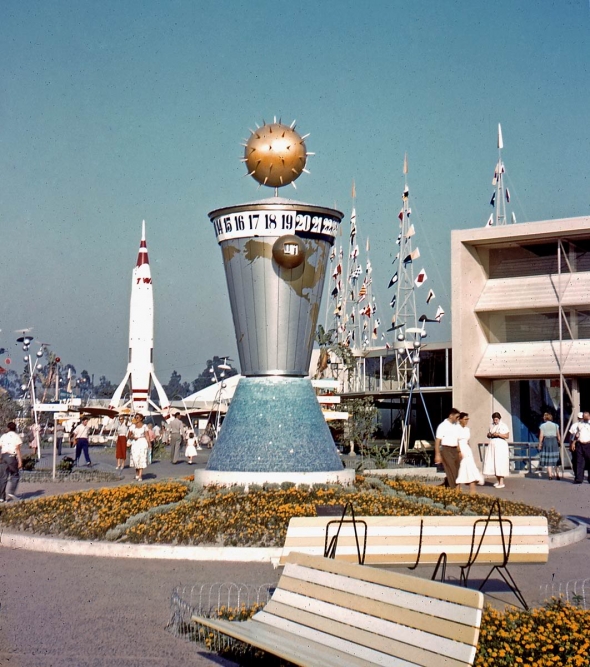
So many of our Lost Legends entries begin here, in the Tomorrowland guests encountered when Disneyland first opened in 1955. There’s a good reason that the stories of so many classics are rooted in this land at this time: because it was a rare disappointment.
Like Walt himself, so many of Disney’s fans look to the past as an idealized, romantic time when things were the way they ought to have stayed. Very few people would say, though, that Tomorrowland was ready to be one of Disneyland’s anchor areas in 1955.
In fact, that Tomorrowland was so far behind schedule during the park’s construction, Walt allegedly ordered that construction on the east side of the park stop entirely. He intended to divert funds from what would be Tomorrowland to the park’s other themed realms. Once Disneyland was on its way, he could reinvest in a Phase II that would open an impressive Tomorrowland more along the lines of the grand display of futurism he envisioned.
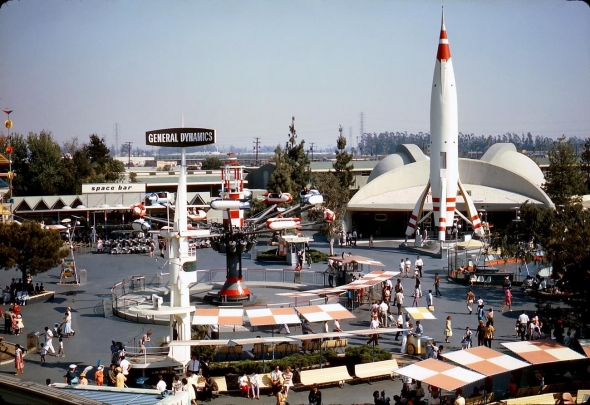
But apparently, in the autumn before the park’s summer opening, he relented. Walt announced that construction should go ahead on Tomorrowland and that, despite his hopes, the land would simply be a corporate showcase; a “World’s Fair” where American companies could display their innovations and peddle their products to the growing middle class.
This Tomorrowland featured such riveting displays as the Kaiser Aluminum Hall of Fame, the Crane Bathroom of Tomorrow, and the Dutch Boy Paint Color Gallery. One of Disney’s few holdouts in the land was a walkthrough display re-using the sets from 1954’s 20,000 Leagues Under the Sea .
Monsanto’s miracle (1957)
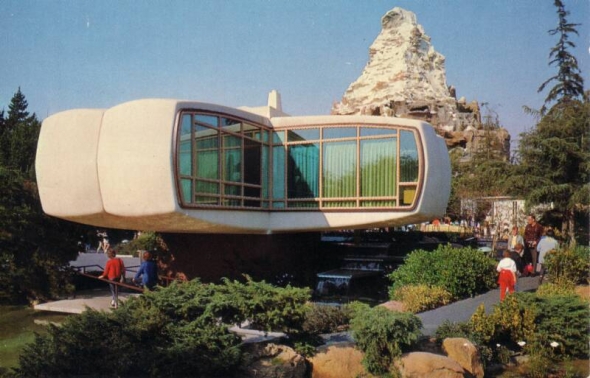
One of the most memorable, though, was the Monsanto House of the Future , which opened in 1957. The strange, cantilevered, white plastic house built just off the park’s Hub was a veritable icon of Tomorrowland at the time, and a coup for the Monsanto Company.
After all, guests who passed through the home of the future got the chance to view ultra-modern furniture comprised entirely of synthetic materials thanks to Monsanto’s groundbreaking efforts, or the inconceivable flat TV suspended right on the wall of the living room!
The most astounding encounter, though, had to be inside the “Atoms for Living” kitchen, featuring a microwave oven. Sincerely the stuff of scientific progress, the countertop microwave oven wouldn’t be commercially available for a full decade, leaving audiences of the 1950s stunned.
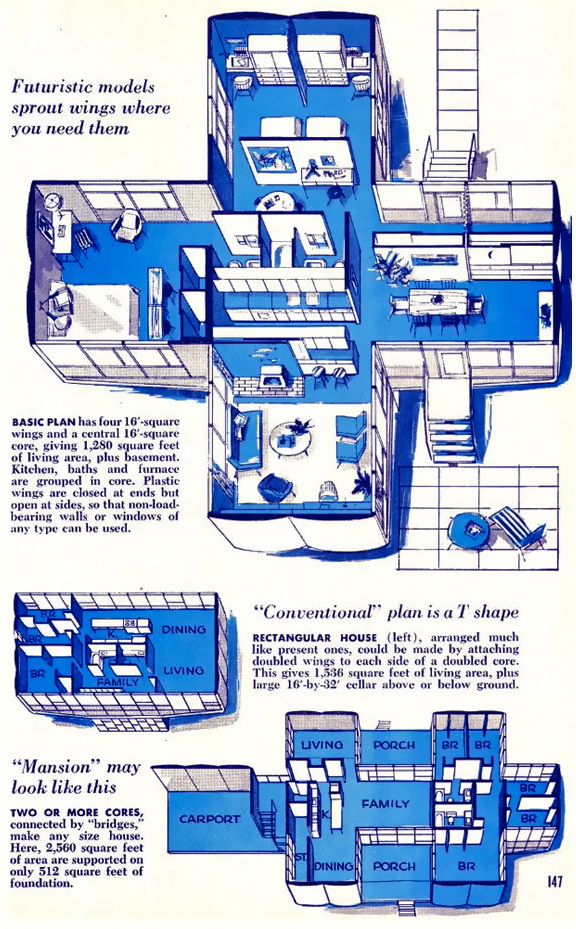
If you asked Imagineers in 1955, they’d tell you that this Tomorrowland and the Monsanto House of the Future were meant to predict the year 1986 – immeasurably far away. (Consider, for example, if today’s Tomorrowland tried to accurately, scientifically predict how the world would look in 2047.) While it might’ve emulated a future as seen from the 1950s, its soaring rocket ships, waving flags, and squared architecture at least gave visitors a sense of what would become Tomorrowland’s core concepts.
Innovating and adding (1959 – 1966)
Still, Walt was never content with this half-hearted display of corporate power and assured his designers that Tomorrowland was not yet complete. His dedication for the land signaled his vision; he called for the land to be “ a vista into a world of wondrous ideas, signifying Man’s achievements… A step into the future, with predictions of constructed things to come. Tomorrow offers new frontiers in science, adventure and ideals. The Atomic Age, the challenge of Outer Space and the hope for a peaceful, unified world .”
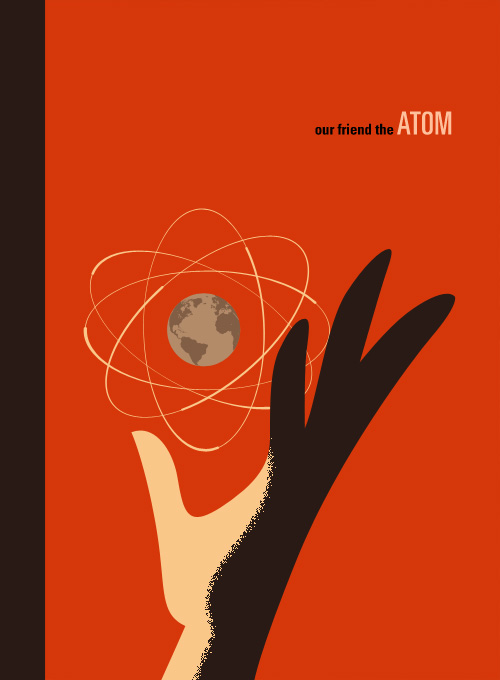
Particularly, it was dreams of an Atomic Age and a Space Age that drove Walt’s narrative. An episode of the Disneyland television series hosted by Walt entitled “ Our Friend the Atom ” aired on January 23, 1957. Nuclear power was the way of the future, and an emerging area of interest with the public. Fittingly, Walt had a plan: “We made plans to build an exhibit at Disneyland to show you atomic energy in action.”
However, the plans to add an atomic attraction to Disneyland were moved to Imagineering’s backburner due, in large part, to a much larger and more pressing expansion meant to bring Tomorrowland up to snuff.
In 1959, the park ceremoniously opened three brand new rides: the Matterhorn Bobsleds (the first tubular steel tracked roller coaster), the Submarine Voyage (the world’s largest peacetime submarine fleet), and the Disney-ALWEG Monorail (the first daily-operating monorail system in the Western hemisphere). So grand were these new and groundbreaking rides, they each earned a new designation, requiring the most expensive and limited ride ticket: an E-Ticket.
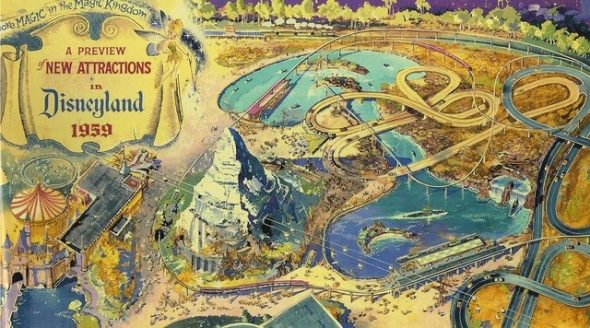
So just four years after the park opened, Tomorrowland had doubled in size and scope and was well on its way to being the Tomorrowland Walt always hoped for.
As the Cold War continued and the Cuban Missile Crisis loomed, the role of atomic power grew and an educational exhibit at Disneyland seemed all the more pressing. Unfortunately, Walt and company were focused elsewhere: the 1964-65 World’s Fair. Designers were working overtime to prepare for the Fair, where Disney had been contracted to provide no less than four headlining attractions for major corporations. Those four attractions would evolve into Great Moments with Mr. Lincoln, “it’s a small world,” Carousel of Progress, and the Peoplemover.
And as the Fair closed in 1965, designers were buoyed by the tremendous innovation they’d used to bring those four attractions to life. So impressive were their newest technologies, they warranted a place in Tomorrowland back at Disneyland.
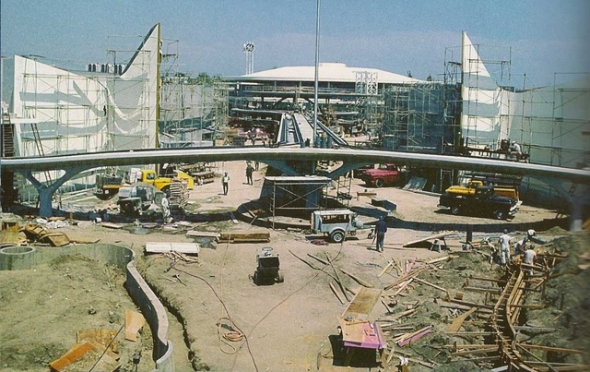
But even a decade after the park opened, Tomorrowland was faltering. The sincere attempt at forecasting the future from 1955 had been inspiring, but it couldn’t hold up. None of the corporate showcases left in Tomorrowland felt convincingly futuristic by the mid-60s. Microwave ovens were the stuff of science fact , not of futurism, and their place in the Monsanto House of the Future was an eye-rolling reminder of a different time. So if Imagineers wanted Tomorrowland to sincerely represent cutting-edge technologies, everything except the 1959 expansion would need a floor-to-ceiling rebuild from scratch.
A great, big, beautiful Tomorrowland was on the way… Read on…
One Reply to “Adventure Thru Inner Space: The View From Within Disneyland’s Molecular Mid-Century Dark Ride”
I really liked the conclusion to this story! It was very well written.
Leave a Reply Cancel reply
Your email address will not be published. Required fields are marked *
Back to top
Adventure Thru Inner Space (Disneyland) – 1967-1985
(Queue Announcements.)
CONTROLLER 1 Atommobiles approaching snowflake specimen. All phases stand by to verify resolving power…
CONTROLLER 2 Phase Blue! Phase Blue! Light wavelength approximately .5000 millimeters. Definition excellent.
CONTROLLER 3 Phase Green! Resolving power decreasing.
CONTROLLER 1 Phase Green! Increase hue angle. Verify.
CONTROLLER 3 Phase Green: hue angle increased to 14 degrees, 29 minutes. Atommobile definition: excellent.
CONTROLLER 1 All phases hold hue angle until forward units reach crystalline stage of snowflake.
NARRATOR (PAUL FREES) Your attention, please! This is the tracking procedure of an adventure through inner space. Adventurous men of science who have made this journey before you are carefully plotting every phase of this incredible journey as you shrink beyond the smallness of an atom—the smallest building block of matter. We wish you an enlightening experience. For, though your body will shrink, your mind will expand.
CONTROLLER 1 All phases, lower resolvable separation as Atommobiles proceed through crystalline stage. Compensate shrinking factor.
CONTROLLER 3 Phase Yellow: hue angle increased to 85 degrees—approaching practical limit.
CONTROLLER 1 Phase Yellow, hold at 90 degrees and stand by to convert to immersion fluids.
NARRATOR You are about to begin your adventure through inner space. We hope this remarkable journey will bring you closer to the adventures experienced daily by men of science—men of vision who make similar treks in a never-ending search for new ways to manipulate molecules for your comfort and convenience. This journey which you are about to take is but one of many such marvelous adventures through inner space.
CONTROLLER 1 Forward units proceeding beyond limits of optical magnification. All phases activate DLX system. Verify voltage compensators.
CONTROLLER 2 Phase Blue: DLX system go. Focusing on H2O molecules. Advanced Atommobiles obscured.
CONTROLLER 1 All primary phases pinpoint C.C. factor of condenser coil—verify triangulation.
CONTROLLER 2 Phase Blue: C.C. factor rectified. Advanced Atommobiles coming into focus.
CONTROLLER 1 All phases lock on to present C.C. factor and hold until all Atommobiles passed beyond DLX range.
NARRATOR Ladies and gentlemen, on this adventure through inner space, you will see that the crystal is a basic form of solid mater. You will see that crystals are made of millions of molecules; that molecules are composed of one or more atoms; and that atoms consist of a nucleus and many electrons that surround it. Here you will see just two of more than a hundred known atoms that scientists are constantly rearranging into molecules to further what nature began.
CONTROLLER 1 All phases, initiate the M.S. precision converters and adjust to the minus 20 million.
CONTROLLER 3 Phase Yellow. Phase Yellow reporting forward units on collision course with H20 molecule
CONTROLLER 1 Increase precision focus to the minus one billion.
CONTROLLER 4 Phase Orange! Forward units obscured. Cannot, repeat, cannot locate Atommobiles.
CONTROLLER 1 All phases increase focus to the minus five billion. Proceed with precision scan procedure.
CONTROLLER 4 Phase Orange: oxygen atoms in sharp focus. Still no evidence of Atommobiles.
CONTROLLER 1 Critical phases continue precision scan procedure.
NARRATOR Your ultimate goal on this adventure thru inner space will be the very hub of this microcosmic solar system—the atomic nucleus. Its capabilities are almost unimaginable. It is a million times smaller than the atom, and yet it contains 99 percent of the atom’s weight. The density of the nucleus is such that if we had one cubic centimeter—half a teaspoon—it would weigh one hundred million tons . We hope this adventure will stimulate your interest to probe further into the mysteries of inner space. For everything we use in our daily lives depends on the universe of the molecule.
CONTROLLER 4 Phase Orange! Phase Orange experiencing chromatic aberrations. Request permission to increase object space index.
CONTROLLER 1 Phase Orange: permission granted. Make adjustments and verify.
CONTROLLER 4 Phase Orange: immersion fluid padded. Objective positive. Atommobiles observed approaching crystal labyrinth.
CONTROLLER 5 Phase Red. Reporting forward units drifting into molecular stage. N.A. factor approaching one point forty.
CONTROLLER 1 Phase Red, hold at N.A. one point sixty. Attention all phases: Atommobiles proceeding beyond limits of normal optical magnification. Stand by to convert to DLX system when forward units enter molecular stage.
NARRATOR Manned flights to Mars and beyond—the glamorous probing of outer space—may one day benefit all mankind. But it is today’s dedicated probing of inner space that will make it possible. It is man’s probing into the realm of the atom and the molecule that has developed the sophisticated materials that will enable our astronauts to survive the rigors of outer space.
(Guests board omnimover vehicles.)
SAFETY ANNOUNCER The front panel will close automatically. Please remain seated at all times.
(Ride motion begins.)
(Attraction narration.)
NARRATOR For centuries, man had but his own two eyes to explore the wonders of his world. Then, he invented the microscope—a mighty eye—and discovered the fantastic universe beyond the limits of his own meager sight.
Now, your adventure thru inner space has begun. Thru Monsanto’s Mighty Microscope, you will travel into the incredible universe found within a tiny fragment of a snowflake. I am the first person to make this fabulous journey—suspended in the timelessness of inner space are the thought waves of my first impressions. They will be our only source of contact once you have passed beyond the limits of normal—
ECHOING VOICE MAGNIFICATION. MAGNIFICATION. MAGNIFICATION. MAGNIFICATION.
NARRATOR I am passing beyond the magnification limits of even the most powerful microscope. These are snowflakes, and yet they seem to grow larger and larger—or can I be shrinking? Shrinking beyond the smallness of a tiny snowflake crystal. Indeed, I am becoming smaller and smaller!
These tiny bits of snowflake crystal tower above me—like an enormous wall of ice! Can I penetrate this gigantic prism? And yet, this wall of ice only seems smooth and solid. From this tiny viewpoint, I can see that nothing is solid—no matter how it appears.
And still I continue to shrink. What compelling force draws me into this mysterious darkness? Can this be the threshold of inner space?
What are these strange spheres? Have I reached the universe of the molecule? Yes! These are water molecules—H20! They vibrate in such an orderly pattern, because this is water frozen into a solid state of matter.
These fuzzy spheres must be the atoms that make up the molecule. Two hydrogen atoms bonded to a single oxygen atom. And I see it’s the orbiting electrons that give the atom its fuzzy appearance.
And still I continue to shrink. Is it possible that I can enter the atom itself?
Electrons are dashing about me—like so many fiery comets! Can I possibly survive?!
I have pierced the wall of the oxygen atom! I am so infinitely small now that I can see millions of orbiting electrons. They appear like the Milky Way of our own solar system. This vast realm… this is the infinite universe within a tiny speck of snowflake crystal.
And there is the nucleus of the atom! Do I dare explore the vastness of its inner space?
No—I dare not go on. I must return to realm of the molecule before I go on shrinking… forever!
Oh, how strange! The molecules are so active now. They have become fluid—freed from their frozen state. That can only mean that the snowflake is melting.
Yes, the snowflake has melted. But there is no cause for alarm. You are back on visual and returning to your normal size.
This has been one of many exciting adventures thru inner space, in a never-ending search for new ways to rearrange molecules for the benefit of mankind.
Now, in our display area you will see modern miracles created by rearranging the molecules of not only water, but of air, coal, petroleum, and many other raw materials.
This is Monsanto.
SAFETY ANNOUNCER When the automatic front panel opens, please step out to your right.
(Music for “Miracles from Molecules” by Richard and Robert Sherman begins.)
CHORUS Miracles from molecules Are dawning every day. Discoveries for happiness In a fabulous array.
A never-ending search is on By men who dare and plan. Making modern miracles From molecules for man.
Every atom is a world, An infinity unfurled, A world of inner space without an end. A world of mystery, Of endless energy, With treasures more than man can ever spend.
Miracles from molecules Are dawning every day. Discoveries for happiness In a fabulous array.
Making modern miracles From molecules for man.
(Guests exit ride vehicles and enter post-show area.)
Help us transcribe more shows and attractions! Support the site by shopping via our Amazon link .
- Find a Library
- Browse Collections
- Journey Into Inner Space
By Brahma Kumaris
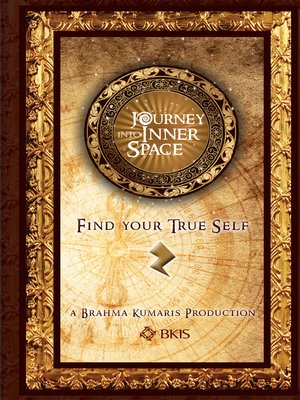
Add Book To Favorites
Is this your library?
Sign up to save your library.
With an OverDrive account, you can save your favorite libraries for at-a-glance information about availability. Find out more about OverDrive accounts.
Brahma Kumaris
BK Publications
01 May 2019
Find this title in Libby, the library reading app by OverDrive.

Search for a digital library with this title
Title found at these libraries:.
- Skip to main content
- Skip to primary sidebar
- Skip to footer
MousePlanet - your resource for all things Disney
Monsanto and Disneyland’s Adventure Thru Inner Space
September 9, 2020 by Jim Korkis
I wrote a book called Secret Stories of Extinct Disneyland that was filled with dozens of two page chapters devoted to attractions, entertainment, restaurants and more that no longer exist at Disneyland.
While I had the good fortune to have actually experienced most of those things I documented, the challenge was how to accurately compress enough important information into less than a thousand words a chapter so that those Disney fans who were unfamiliar with those experiences could better understand and appreciate what they were like.
This week I decided I wanted to expand one of those entries over three-fold the length by utilizing some material I have from the original training manual issued to Disneyland cast members in 1967 along with my own research.

Adventure Thru Inner Space that was located at the front of Tomorrowland in Disneyland from August 1967 to September 1985 gave guests a chance to be miniaturized “beyond the limits of normal magnification.”
The attraction was part of the new Tomorrowland that opened in 1967 and the building took the location of the former Monsanto Hall of Chemistry and the 20,000 Leagues Under the Sea walk-through exhibit.
Because of Monsanto's participation, the attraction required none of the famous Disneyland Alphabet tickets but was completely free although younger children had to use a special coupon in their ticket book if they wanted to ride unsupervised by their parents. It became a “C” Ticket attraction in 1972 and Monsanto dropped its sponsorship in 1977 although the ride continued to operate for another eight years but with the Monsanto references removed.
Guests boarded Disney's first theme park Omnimover vehicles called “Atomobiles” and went through the “Mighty Microscope” (12-feet high, 37-feet long) into the microscopic world of a snowflake.
The vehicles continued to seemingly diminish in size while guests heard the audio log of the first explorer (actor Paul Frees) helping them understand what they were seeing around them on the 682-foot winding loop of track.
Eventually, the guests had shrunk to such a tiny size that they confronted the nucleus of the atom (containing a strobe light inside) and had to quickly return to normal size as the snowflake began to melt and find themselves once again in a “world of comfort and convenience, made possible through miracles from molecules.”
This phrase inspired the theme song Miracles from Molecules for the attraction written by the Sherman Brothers at the request of Walt Disney.
“Miracles from molecules around us everywhere. There are miracles from molecules in the Earth, the sea, the air. “Every atom is a world, an infinity unfurled, a world of inner space without an end. A world of mystery, of endless energy with treasures more than man can ever spend. “A never-ending search is on by men who dare and plan making modern miracles from molecules for man!”
That upbeat song was heard at the beginning and end of the ride. The rest of the background score was composed by Buddy Baker.
Even as early as 1957 and the episode of the Disney weekly television show entitled Our Friend, the Atom (January 23, 1957), Walt had considered some type of attraction at Disneyland dealing with exploring the world of atoms.
Working with Dr. Charles Allen Thomas, the chairman of the Monsanto Company (that manipulated molecules), the Imagineers decided that frozen water would be the easiest and most understandable concept for guests when explaining molecules. Imagineer John Hench did some initial concept sketches and it was considered naming the attraction the Magic Microscope or Micro World.
The distinctive blue cocoon-shaped Omnimovers not only moved guests quickly and efficiently through the attraction (over 3,000 an hour), but controlled what the audience would see. The curving sides of the vehicle prevented the guests from looking anywhere else besides where the vehicle was facing, as well as creating an acoustical chamber so that the narration could be heard more clearly through individual speakers in each vehicle.
“We are hoping the excitement generated in our attraction by the creativity of many Disney artists will bring alive the excitement of Inner Space,” Thomas said.
Those Disney artists included Imagineer Claude Coats who primarily designed much of the attraction and was known to concentrate on the environment rather than characters in his storytelling of Disney theme park attractions.
To make the free attraction more intimate, the Imagineers placed objects like hanging snowflakes within easy reach of the guests in the Atomobiles, which was a huge mistake.
People grabbed at items and even tried to physically destroy them. So the Imagineers came up with the concept now called “Envelope of Protection” meaning when designing future attractions to put things well out of easy reach of guests in a ride vehicle.
The darkness and intimacy of the attraction encouraged everything from covert smoking of marijuana to amorous antics. When the attraction finally closed, an angry guest wrote a complaint letter that included the interesting statement: “How dare you remove it! My son was conceived on that ride!”
The attraction was replaced by Star Tours. The latest version, Star Tours: The Adventures Continue, features the Mighty Microscope visible when escaping the under-construction Death Star above Geonosis.
When the attraction opened, Disneyland University put together a 14-page spiral bound booklet to acquaint cast members with the attraction.
“You now become a host or hostess who will reflect the Monsanto image of personal friendliness in an organization which is a scientific world pioneer in that 'other frontier'…inner space. We welcome you as a member of the Monsanto/Disney team with the hope that you'll have an enjoyable and fulfilling experience hosting this new attraction…Adventure Thru Inner Space. “Remember…every day and every hour…that you now represent Monsanto…its name…its product…and its 60,000 people throughout the world. You'll want to know about this exciting attraction…about Monsanto products…about the Monsanto organization…and its interesting history.”
The booklet went into great detail about the story of the attraction and the story of Monsanto following Walt Disney's personal philosophy that cast members either needed to know the answers or know where to get the answers if guests asked a question.
The following is the overview of the attraction as contained in the booklet:
“An unusual experience begins in the pre-show area at the moment Disneyland's guests enter the Monsanto Pavilion. To the strains of the Monsanto theme song, Miracles from Molecules , guests will proceed toward a Mighty Microscope, the primary focal point of the attraction. “On a walk-way of Monsanto product they move past a huge electronically annotated control board that will track their progress through various phases of their journey into the vastness of inner space found within a tiny fragment of a snowflake. “Monsanto's guests will board one in an endless chain of ATOMOBILES from a platform that rotates at the exact speed as the approaching vehicles and proceed into the eye-piece of the mighty microscope. “To the people waiting to board, it appears that the Atomobiles are actually becoming smaller as they proceed along a translucent section of the tube. “A pulsing beam of light from the “objective-lens” end of the Mighty Microscope pierces a transparent sphere containing a swirling snow storm, creating the illusion that the Atomobiles have actually been reduced to the scale of a snowflake. “The sounds of the tracking crew can be heard in the background speaking in their technical jargon as they establish contact with Atomobiles penetrating into the vastness of inner space.
“The show then proceeds through the following acts: Act 1…The Journey Into a Snowflake Act 2…The Universe of the Molecule Act 3…The Vastness of Inner Space Act 4…The Return to Normal Post-Show…Miracles from Molecules Product Display”
The interest in the attraction was not just that it was free but that it was like being inside a science-fiction film from the 1960s based not on speculation but on actual science. It seemed similar to the film The Incredible Shrinking Man (1957) or one of the nine special television episodes in the Bell System Science Series.
In addition, having Paul Frees as the narrator brought to mind science-fiction including his narration of the Disney “Man in Space” trilogy of television shows in the 1950s and his work in George Pal films as a radio reporter announcer in War of the Worlds (1953) and the “talking rings” in The Time Machine (1960) or his on-screen appearances as a scientists in movies like The Thing from Another World (1951) and Space Master X-7 (1958).
For those who never got a chance to ride this attraction, here is a brief summary of each act using the narration from the actual script:
Act I: Journey Into a Snowflake
As the Atomobiles leave the loading platform and enter the darkness of the Mighty Microscope, they are greeted by the voice of the narrator heard from individual speakers in each vehicle.
“Welcome to an adventure through inner space…through Monsanto's Mighty Microscope you will journey into the incredible universe found within a tiny fragment of a snowflake.”
The Atomobiles appear to pass through a swirling snow storm and as they proceed through the illusion the snowflakes become larger, revealing their delicate structure.
“I am the first person to make this fabulous journey. Suspended in the timelessness of inner space are the thought waves of my first impressions. They will be our only source of contact once you pass beyond the limits to normal MAG-NI-FI-CATION….”
The last word of the narrative becomes amplified, echoey and distorted and fades out. The snowflakes become gigantic geometric shapes. The voice of the narrator is now hollow and etherealized as though it might be his thoughts suspended in time.
“Am I truly passing beyond the magnification limits of even the most powerful microscopes? Can I be shrinking beyond the smallness of a tiny snowflake?…Surely it must be my imagination.”
The crystals become gigantic prisms of solid ice.
“And yet…How is it that this tiny bit of crystal towers above me like an enormous wall of solid ice? Indeed I am becoming smaller…and…smaller….”
The towering walls of solid ice take on porous character and the Atomobiles proceed into an enormous, shimmering, almost forbidding labyrinth.
“From this tiny viewpoint I see that nothing is solid. All matter must be penetrable…what compelling force draws me into this mysterious darkness?”
The shimmering crystals blend into an area of total darkness.
“I have lost all sense of direction…as though I were drifting…can this be the threshold of INNER SPACE?”
Act II: The Universe of the Molecule
The Atomobiles enter a strange world filled with vibrating, rotating fleecy spheres. As the Atomobiles proceed into the cluster, it can be seen that each unit is made up of two smaller spheres uniformly attached to a single larger one.
“What are these strange spheres? Have I reached the universe of the molecule…Yes, these must be water molecules…H 2 O. They vibrate in such an orderly pattern because this is water frozen into the solid state of matter.”
The shrinking guests are suddenly aware of orbiting lights that form gigantic molecules.
“I see now that it is the orbiting electrons that give the atom its fuzzy appearance…and still I continue to shrink until I am able to pierce the wall of this oxygen atom.”
The music builds to a great crescendo as the Atomobiles proceed through a shower of orbiting smears of colors.
“Electrons are dashing about me like so many fiery comets…can I possibly survive?”
Act III: The Vastness of Inner Space
The violent meteor shower marks the breakthrough into the universe inside the oxygen atom. The stillness inside the atom and the illusion of vastness are a marked contrast to the violent breakthrough.
“I am so infinitely small now that the orbiting electrons of this tiny speck of a snowflake crystal appear like the Milky Way of our own familiar world.”
A rotation of the Atomobiles reveals the mysterious throbbing nucleus.
“And there is the nucleus…( thumping sound )…Do I dare enter the unknown vastness of its inner space?…No, it is better that I return to the realm of the molecule before I am tempted to go on shrinking…forever.”
The Atomobiles proceed through an abbreviated version of the breakthrough effects and emerge again into the world of the molecule.
Act IV: The Return to Normal
The journey into the Atom completed, the remaining few seconds are devoted to a quick return to normal. The vibrating H 2 O molecules of Act 2 are now fluid tumbling water molecules that blend into bubbles.
“Hmmm…How strange…The molecules are so active now. That can only mean that the snowflake is beginning to melt…”
The reverberated voices of the Tracking crew interrupt the narrative with a note of urgency.
“Snowflake melting! Stand by for re-entry! M-Scope counting…minus 10 million…9 million…8….”
The shadowy form of a huge optical instrument can be seen through the water molecule and bubble effects. As the Atomobiles pass beneath it, the guests see a huge three-dimensional, animated eye looking down at them and moving back and forth as if it is watching the journey.
“Atomobiles back on visual…. Continue re-entry procedure. Oscilloscope scanning. Thermotaxis affirmative. All phases normal.”
The Monsanto musical theme builds to a finale as the Atomobiles proceed to the show exit and enter the Product Display area and approach the unloading platform.
“Welcome back to our familiar world of comfort and convenience…made possible through miracles from molecules. In our display area, you will see modern miracles created by rearranging the molecules of not only water but of the air…coal…petroleum and many other raw materials. This is Monsanto today.”
Ladies and gentlemen…. Welcome to Miracles From Molecules. Please watch your step as you exit from the Atomobile.
While the training book was 14 pages long, seven pages were devoted entirely to the history and operation of Monsanto.
Why? Well according to the final page:
“As you go on stage, remember that you are a personal representative of 60,000 Monsanto employees around the world. To our many Disneyland guests, you are Monsanto…they will expect you to answer questions of many types regarding Monsanto Company and their products. “Yes…your challenge is a dual role…a member of the Disneyland cast, and an equally important member of the Monsanto family. Good luck in your new role as you bring our guests into another dimension…a fascinating 'Adventure Thru Inner Space'.”
Some of that material that Disneyland cast members were expected to know about Monsanto included the following:
Monsanto was founded in 1901 by John F. Queeny, a successful drug executive who was convinced that saccharin, a super-sweetener then made only in Germany could be manufactured profitably in the United States. With his savings and capital invested by others, he launched Monsanto in St. Louis, Missouri, naming the company for his wife Olga Monsanto Queeny.
During Monsanto's first 20 years, organic chemicals such as caffeine, vanillin, phenolphthalein and aspirin were added to a growing list of products. From 1920 to 1940, the company expanded its product line into new fields of chemistry and adding manufacturing facilities at several locations in the United States and abroad.
The formation of the Chemstrand Corporation in 1949 marked Monsanto's entry into the field of man-made fibers. The Lion Oil Company Division was formed in 1955, giving Monsanto a necessary foothold in the field of petroleum, the raw material for many Monsanto products.
In 1957, Monsanto expanded its plastics field which resulted in 1963 with it producing a broad line of plastic containers and oriented polystyrene sheeting.
When Adventure Thru Inner Space opened, the Monsanto Company was the third largest chemical company in the United States and the fifth largest in the world. In term of sales and assets, it was the nation's 33 rd largest industrial company.
The company had 43 plants and 10 laboratories in the United States, and manufacturing interests in 21 countries. It employed more than 60,000 people world-wide. Monsanto's product line which began with just one product, saccharin, included more than a thousand chemical, fiber, plastic and petroleum products.
Monsanto was one of the original participants in Disneyland when it opened in 1955 sponsoring the Hall of Chemistry at the front of Tomorrowland from July 17, 1955 to September 19, 1966.
It was a free walk-through exhibit of informational displays demonstrating the benefits of chemical engineering with the Chematron (eight huge, oversized test tubes containing the basic materials from nature like coal and water used in the making of over 500 Monsanto products) and electrified wall items among other things. Guests could get a free brochure with more information.
From June 1957 to December 1967, Monsanto hosted the House of the Future at the entrance to that land
In 1953, Monsanto's Plastic Research Laboratory partnered with the Massachusetts Institute of Technology (MIT) to develop a method of using its plastics in house construction. It decided that only a full-scale display house would best demonstrate these new applications both to builders and the public. As a result, it became a free attraction at Disneyland for guests to walk through and discover the wonders of future living.
The house was located to the left side of the entrance to Tomorrowland and was a white cruciform with four gracefully curved fiberglass wings cantilevered from a 256-square-foot central core. It was like a cross or a “plus” sign and not only provided full daylight for each individual room, but sound reduction, privacy, and the ease in adding extra modules.
Each wing was 8-feet tall, 16-feet wide, and 16-feet long. Overall, the house was 1,280-square feet and had three bedrooms, two baths, a living room, a dining room, a family room, and a kitchen. The house opened June 12, 1957 after a media preview a day earlier.
The floors, walls and ceilings were made of plastic. The Kelvinator Division of American Motors Corporation designed the “Atoms for Living Kitchen” that had appliances that either dropped down from overhead, like the “cold zone” units that took the place of a refrigerator, or popped up from the counter, like the new microwave oven.
Sylvania Electric Products Company provided adjustable panel lighting behind polarized plastic ceiling tiles that could mimic “the glow of natural sunlight”.” Bell Telephone contributed the push-button speakerphone (that would make its general public appearance years later at the 1964 New York World's Fair) with “pre-set” dialing to call selected numbers, like a doctor or the school. In the bathroom there was a phone with a video screen so you could see who was at the front door, but they couldn't see you.
The bathroom featured a movable sink that, at the push of a button, could adjust higher or lower for the person using it. Devices included an electric razor and an electric toothbrush with an attached cord. The living room had a large, wall-mounted (non-working) television screen and, of course, a built-in stereo sound system.
While today, many of these innovations seem quaint and unexceptional, it must be remembered that at the time they were considered revolutionary.
More than 20 million people (more than the entire population of the state of California at the time) visited by the time the house was finally removed in 1967.
The house proved more durable than expected when the original plan for a one-day demolition in late 1967 turned into a long two-week project. The building had to be hack-sawed piece by piece and parts crushed with wrapped chains into removable pieces when the wrecking ball kept bouncing off the sides of the house.
The area was transformed into a beautiful Alpine Garden and later, in 1996, Triton's Garden as the home for Ariel, and in 2008, became Tinker Bell's home of Pixie Hollow.
Monsanto and Disneyland had a decades long association that resulted in several interesting free experiences for guests but today the world has changed and only memories remain.
MousePlanet is your independent consumer guide to Disney travel and vacations, covering Disneyland, Walt Disney World and the Disney Cruise Line. Look to MousePlanet for daily news, weekly theme park updates, and detailed travel and resort guides for your favorite Disney destinations. As with any endeavor of this size and complexity, we couldn't hope to succeed without the assistance of our readers. We encourage you to submit news, updates and feedback from your Disney travels.
- About MousePlanet
- Privacy Policy
MousePlanet is not associated in any official way with the Walt Disney Company, its subsidiaries. or its affiliates. The official Disney site is available at www.disney.com . This MousePlanet Web site provides independent news articles, commentary, editorials, reviews. and guides about the Walt Disney Co. All information on this site is subject to change. Please contact destinations in advance to confirm the most up-to-date information.

Three Things You (Probably) Don’t Know About Inner Space
by Todd James Pierce | Jun 1, 2012 | 6 comments
This is downright amazing! The footage (where the heck did you get it?) the photos, the audio, the information! Great job!
THANK YOU for this. As a huge fan of ATIS, any new material is exciting… This has made my day 🙂 Also, I wish we could transition back to the optimistic forward-thinking the film discusses… why have a Land in which we are told to fear tomorrow’s science, instead of celebrating the possibilities it holds as we did in the 50s? I recognize that there have been improvements since the 80s/90s but Tomorrowland still lacks that optimism seen in its early years. Just my two cents, as relevant to the film 🙂
Great footage; thanks for sharing 🙂
There was just something amazing about ATIS; Maybe because so much of it was abstract? I don’t think a ride like this would stand a chance of getting made today.
Next to COP, this was my favorite ride as a kid! Thanks for sharing the insights and rare footage. I still can see most of it in mind “For Centuries…”
Thank you so much for this post… just fantastic stuff.
Recent Posts
- From the Archive Box: Toy Trade Magazine “Playthings”- Walt Disney’s Gremlins of the R.A.F.
- Podcast: The story of Herb Ryman, designer of Disney parks and films. Part One.
- Virtual Recreation Privacy Policy
- Project: Fairwinds Version 2.0 has been released
- March 2020 MotM- Darby O’Gill and the Little People (Part 1)
Recent Comments
- Disney Boy on Podcast: The story of Herb Ryman, designer of Disney parks and films. Part One.
- Chad on Adventure Thru Inner Space VR – Project: Snowflake – UPDATED –
- Michael Czeiszperger on Project: Fairwinds Version 2.0 has been released
- Drake on American Experience: Early Problems?
- Mike L Schilling on New Podcast – DHI 011 – The Pinto Colvig Story
Pin It on Pinterest
Enjoy this.
Then, share this post with your friends!

- Kindle Store
- Kindle eBooks
- Biographies & Memoirs

Promotions apply when you purchase
These promotions will be applied to this item:
Some promotions may be combined; others are not eligible to be combined with other offers. For details, please see the Terms & Conditions associated with these promotions.
Audiobook Price: $18.80 $18.80
Save: $11.31 $11.31 (60%)
Buy for others
Buying and sending ebooks to others.
- Select quantity
- Buy and send eBooks
- Recipients can read on any device
These ebooks can only be redeemed by recipients in the US. Redemption links and eBooks cannot be resold.

Download the free Kindle app and start reading Kindle books instantly on your smartphone, tablet, or computer - no Kindle device required .
Read instantly on your browser with Kindle for Web.
Using your mobile phone camera - scan the code below and download the Kindle app.


Image Unavailable

- To view this video download Flash Player
Follow the author

From Outer Space to Inner Space: An Apollo Astronaut's Journey Through the Material and Mystical Worlds Kindle Edition

The sixth man who walked on the moon shares his journey to the stars, into the mind, and beyond.
In February 1971, as Apollo 14 astronaut Edgar Mitchell hurtled Earthward through space, he was engulfed by a profound sense of universal connectedness. He intuitively sensed that his presence and that of the planet in the window were all part of a deliberate, universal process, and that the glittering cosmos itself was, in some way, conscious. The experience was so overwhelming, Mitchell knew his life would never be the same.
For the next thirty-five years, he embarked on another journey, an inward exploration of the ineffable mystery of human consciousness and being. Mitchell left NASA to form the Institute of Noetic Sciences (IONS). There he initiated research in areas of study previously neglected by mainstream science and constructed a theory that could explain not only the mysteries of consciousness, but also the psychic event—what spiritualists call a “miracle” and scientists dismiss altogether.
Mitchell also created a new dyadic model of reality, revealing a self-aware universe not predetermined by the laws of physics, preordained by deities, or infinitely malleable. While human actions are generally subject to the laws of physics, these laws are also influenced by the mind.
From Outer Space to Inner Space traces two remarkable journeys—one through space and one through the mind. Together they fundamentally alter the way we understand the miracle and mystery of being, and ultimately reveal humankind’s role in its own destiny.
Previously published as The Way of the Explorer, this edition includes a new foreword by Avi Loeb, an afterword by Dean Radin, and a postscript chapter by the author.
- Print length 300 pages
- Language English
- Sticky notes On Kindle Scribe
- Publisher New Page Books
- Publication date January 1, 2023
- File size 6213 KB
- Page Flip Enabled
- Word Wise Enabled
- Enhanced typesetting Enabled
- See all details
Customers who bought this item also bought

From the Publisher

Editorial Reviews
"Edgar Mitchell has produced a miraculous book. He writes as both a scientist and a spiritual seeker. In sharing from his heart, Dr. Mitchell has provided us with a blueprint for revolutionizing our lives and our planet."
"[At] the Institute of Noetic Sciences...he came to some fascinating conclusions, detailed here and based on principles of resonance, regarding a possible natural explanation for psychic powers...He grounds his ideas in data and reason, however, making this a strong offering."
"Edgar was a man very willing to go where no one has gone before."
"Offers a vision in which technology and intuition are harmonized in pursuit of a more advanced consciousness."
About the Author
Product details.
- ASIN : B09T9BX64T
- Publisher : New Page Books (January 1, 2023)
- Publication date : January 1, 2023
- Language : English
- File size : 6213 KB
- Text-to-Speech : Enabled
- Screen Reader : Supported
- Enhanced typesetting : Enabled
- X-Ray : Enabled
- Word Wise : Enabled
- Sticky notes : On Kindle Scribe
- Print length : 300 pages
- Page numbers source ISBN : 1637480091
- #307 in Occult Parapsychology
- #608 in Biographies of Scientists
- #2,384 in Scientist Biographies
About the author
Edgar mitchell.
Discover more of the author’s books, see similar authors, read author blogs and more
Customer reviews
Customer Reviews, including Product Star Ratings help customers to learn more about the product and decide whether it is the right product for them.
To calculate the overall star rating and percentage breakdown by star, we don’t use a simple average. Instead, our system considers things like how recent a review is and if the reviewer bought the item on Amazon. It also analyzed reviews to verify trustworthiness.
- Sort reviews by Top reviews Most recent Top reviews
Top reviews from the United States
There was a problem filtering reviews right now. please try again later..
Report an issue
- Amazon Newsletter
- About Amazon
- Accessibility
- Sustainability
- Press Center
- Investor Relations
- Amazon Devices
- Amazon Science
- Sell on Amazon
- Sell apps on Amazon
- Supply to Amazon
- Protect & Build Your Brand
- Become an Affiliate
- Become a Delivery Driver
- Start a Package Delivery Business
- Advertise Your Products
- Self-Publish with Us
- Become an Amazon Hub Partner
- › See More Ways to Make Money
- Amazon Visa
- Amazon Store Card
- Amazon Secured Card
- Amazon Business Card
- Shop with Points
- Credit Card Marketplace
- Reload Your Balance
- Amazon Currency Converter
- Your Account
- Your Orders
- Shipping Rates & Policies
- Amazon Prime
- Returns & Replacements
- Manage Your Content and Devices
- Recalls and Product Safety Alerts
- Conditions of Use
- Privacy Notice
- Consumer Health Data Privacy Disclosure
- Your Ads Privacy Choices
Exploring the Inner Space: A Journey into the Depths
Posted on april 20,2023.
Introduction:
Welcome, fellow seekers, to a transformative expedition into the uncharted terrain of our inner space. In our fast-paced, interconnected world, it is all too easy to overlook the significance of introspection and self-discovery. Just as we explore the vast wonders of the external universe, our inner realms also hold boundless potential and mysteries waiting to be unraveled. Join me on this virtual journey as we embark on an exploration of the depths within ourselves.
Unveiling the Inner Landscape:
Imagine your mind as a vast landscape, with its own unique topography and hidden treasures. As we venture into this inner terrain, we encounter thoughts, emotions, memories, and beliefs that shape our understanding of the world and ourselves. Just like an explorer mapping out new territories, we can delve deeper into our psyche, navigating through the layers to gain insights into who we truly are.
Cultivating Self-Awareness:
Self-awareness acts as our compass in this inner odyssey, illuminating the paths we choose to traverse. It involves observing our thoughts, feelings, and reactions without judgment, and developing a keen understanding of our strengths, weaknesses, and desires. Through practices such as mindfulness and meditation, we can cultivate this awareness and forge a profound connection with our inner selves.
Confronting Shadows:
In the depths of our inner space lie the shadows—the repressed or ignored aspects of ourselves that yearn for acknowledgment. These shadows can manifest as fears, insecurities, or unresolved traumas. By bravely confronting them, we can integrate these fragmented parts of our being and experience profound healing and growth. Embracing our shadows allows us to unleash our full potential and live authentically.
The Power of Intuition:
Intuition is the compass that guides us through the uncharted territories of our inner space. It whispers softly, offering insights and nudges that can lead us to our true purpose and passions. Learning to trust and honor our intuition enables us to make decisions aligned with our deepest values and aspirations, unlocking new realms of self-discovery and fulfillment.
Creativity and Inner Expression:
Our inner space is a wellspring of creativity, waiting to be tapped into. Whether through art, music, writing, or other forms of self-expression, we can channel our innermost thoughts and emotions into tangible creations. These acts of creativity not only provide an outlet for self-expression but also facilitate self-discovery, enabling us to access hidden depths within ourselves.
The Transformative Power of Reflection:
Taking time for reflection is like shining a spotlight on the intricacies of our inner landscape. Journaling, contemplation, or engaging in meaningful conversations with trusted confidantes allows us to delve into our experiences and extract wisdom from them. Reflection grants us the opportunity to learn from our mistakes, celebrate our successes, and make conscious choices aligned with our authentic selves.
Integration and Wholeness:
Ultimately, our inner space exploration is about integration and wholeness. It is the journey of embracing all aspects of ourselves—the light and the dark, the known and the unknown—to create a harmonious and authentic existence. As we embark on this expedition, let us remember that the treasures we seek are already within us, waiting to be discovered and celebrated.
Conclusion:
In conclusion, exploring the depths of our inner space is a lifelong journey that leads to personal growth, self-discovery, and authenticity. By cultivating self-awareness, confronting our shadows, and embracing our intuition, creativity, and reflection, we can achieve integration and wholeness, ultimately living a life filled with purpose and compassion.
https://tinyurl.com/recreateyourinnerspace
"Exploring the Impact of Illogical Thought Processes on Decision Making and Society"
Date posted: May 22,2023
In a world inundated with information and complex challenges, the ability to think critically and logically is crucial. Howeve…
"Unveiling the Transformative Effects of Mindfulness Practices"
Date posted: May 18,2023
In today's fast-paced and technology-driven world, maintaining focus has become increasingly challenging, particularly for the younger generation. …
"Unlocking the Potential of Logical Reasoning for Personal Growth and Success"
Date posted: May 21,2023
In our journey through life, we often find ourselves holding onto beliefs that seem to defy reason and logic. These illogical belief…
"How Holistic Living Promotes Optimal Well-being and Stress Management"
Date posted: May 23,2023
Introduction:
In today's fast-paced world, stress has become an inevitable part of our lives. When stress hits, many of us turn to food for comfort, seek…
Have a Question? Reach out to us
We are there for you.
- Contributors
- Valuing Black Lives
- Black Issues in Philosophy
- Blog Announcements
- Climate Matters
- Genealogies of Philosophy
- Graduate Student Council (GSC)
- Graduate Student Reflection
- Into Philosophy
- Member Interviews
- On Congeniality
- Philosophy as a Way of Life
- Philosophy in the Contemporary World
- Precarity and Philosophy
- Recently Published Book Spotlight
- Starting Out in Philosophy
- Syllabus Showcase
- Teaching and Learning Video Series
- Undergraduate Philosophy Club
- Women in Philosophy
- Diversity and Inclusiveness
- Issues in Philosophy
- Public Philosophy
- Work/Life Balance
- Submissions
- Journal Surveys
- APA Connect

Recently Published Book Spotlight: Inner Space Philosophy

James Tartaglia is Professor of Metaphysical Philosophy at Keele University, UK. He is the author of Philosophy in a Meaningless Life (2016), Philosophy in a Technological World (2020), and his newest book Inner Space Philosophy , which was released today. In this Recently Published Book Spotlight, Tartaglia discusses how his frustration with the standardized style of philosophy today inspired him to write this book and the creative approach he took in it.
Why did you feel the need to write this work?
I wrote it because I’ve come to think that today’s philosophy neglects the stylistic and imaginative presentations of original philosophical ideas found in some of the most influential philosophy of all time, such as Plato’s dialogues and allegories, Descartes’ meditations, Nietzsche’s aphorisms, and Sartre’s novels and plays. Philosophy has become stylistically standardized, with the standard in question being a professional academic one modelled on science. Any deviation from the standard raises the suspicion that what is on offer is merely popularizing work, not original philosophy. I think this indifference to style and art has stifled creativity in philosophy, lessened its appeal, and made it more insular, which has led outsiders to question philosophy’s value with increasing aggressiveness. I think exploring new styles will help the discipline expand into the public consciousness, where philosophical reflection might start to play a much more important social role in our technologically driven world; and with the way technology is going, we’re going to be needing philosophy more than ever before, as I argued in Philosophy in a Technological World (2020).
In the introduction, I justify my unconventional approach in conventional academic prose—after that things really kick off. First, you get the aphoristic writing of Chapter 1, designed to get you thinking about whether philosophy is as real to people as it used to be, and whether it could ever again be a burning passion for enlightenment and illumination, a lifelong quest. Chapter 2 is a series of ethereal encounters with philosophy-spirits, who explain their philosophies to you in a friendly manner; well, usually friendly, some of them are a bit prickly—this chapter is much bigger than the rest, it’s a book-within-a-book, I’ll tell you more about it later.
Chapter 3 is a parable about two spirits called Lady Luck and Fate, and the day when they met the terrifying apparition called Philosophy and awakened our sleeping Destiny. The style of this chapter is inspired by the Roman satirist Lucian, I’m a big fan, and the theme is the connection between metaphysical materialism, social materialism, and neglect of philosophy. Chapter 4 returns to the aphoristic style, as we imagine the first prehistoric man or woman to speculate about the meaning of life. I then try to forge a new concept of ‘meaningfulness’ which might prove useful if technology drives us further into inner space, as I expect will happen, and as tech-leaders are trying to make happen.
Chapter 5 looks destined to be the most popular, from the reactions I’ve seen so far—and it’s my favourite too. It’s a spoof biography of Gambo Lai Lai the Cynic philosopher, who lived in Trinidad in the golden era of Calypso music, the 1920s and ‘30s; the fusty style of his anonymous biographer is loosely inspired by Diogenes Laertius. Gambo Lai Lai was a real historical figure, a larger-than-life character who used to stand on street corners making speeches in an antiquated and florid English; I slip in an actual quote, his words are unforgettable. All this public exhorting in ‘old angle’, as he called it, led to Gambo being repeatedly arrested and jailed for disturbing the peace, but the people loved him, he was a local celebrity and calypsonians recorded songs about him. As to whether he really was a Cynic philosopher I reserve comment, but if the chapter does its work, it should awaken in the reader a real sense of the spirit of ancient Cynic philosophy, and of how it might have something important to say to us in our tech-driven world.
Finally, in Chapter 6, we get to listen in on an overheated discussion between a hero called Barney and a villain called Cuillin, as they discuss Inner Space Philosophy , the book that saved the world, analysing the contents chapter by chapter. Cuillin raises the most savage criticisms I could think of, a hostile reviewer would do well to improve on Cuillin’s performance, he absolutely trashes it, or tries. And then the book ends on the ‘wolves’ theme I develop in ‘chasers’ at the end of each chapter—the overall conclusion of the book emerges as your favourite characters return for one last scene.
Do you see any connections between your professional work and personal life?
Well, there you go, a perfect illustration of what I’m talking about in Chapter 1 when I say philosophy doesn’t seem as real as it used to, that it’s all become a bit watered down. Just imagine asking Plato if he saw any connections between his professional work and personal life? He’d think you were barmy—he was a philosopher, so he lived the philosophical life. It reminds me of when Alan Watts said the new model of the philosopher is of the “nine-to-five businessman, going to the office with his briefcase to ‘do philosophy’ in the same spirit as an accountant or research chemist.” He had a point, right? Given what philosophy has traditionally been, you really shouldn’t have to ask me a question like that. As things stand, however, it’s a very good question and I shall answer it. In my case, philosophy is no longer a day job, if it ever was (can’t remember), philosophical thoughts come to me whenever and wherever they want, you can never entirely turn it off and I very rarely want to, I’d prefer to progress in the opposite direction, to try to become more like the philosophers in this book.
How do you relate your work to other well-known philosophies?
Ah, so you finally asked … this gives me the opportunity I needed, since I promised to tell you about the book-in-a-book which is Chapter 2. It’s where the reader gets to “encounter” a historical parade of my favourite philosophers. And what I mean by “encounter” is that I pretend to be them, talking to you very directly in an imaginary, magical place. I start with Plato (427-347 BC), who tells you a bit about his philosophy and life, before revisiting the Atlantis myth he invented, this time to expand on it with a new tale, one with a clear moral for us concerning mobile phone addiction.
Then we move onto Plotinus (204-270 AD), the Roman philosopher who advocated strict introspective metaphysical mediation for the purposes of “merging with the One,” an intense spiritual ecstasy in which we experientially grasp the truth of being at one with the universe—that’s what Plotinus was always trying to do in his everyday life, while remembering to be kind and considerate to lesser souls, of course.
The third encounter is with Chinese philosopher Xuanzang (602-664 AD), a leading figure in the “consciousness-only” school of Buddhism—after he’s told you about his amazing 16-year adventure in India, he gives you a straightforward account of the outlines of his philosophy, one which you’ll notice has a lot in common with the kind of things Plato and Plotinus were saying. The fourth encounter is with Nana Abena Boaa, who was an African queen from the 17th century about whom nothing else is known—so unless I got very lucky, she wasn’t really a philosopher. Still, anything can happen in my encounters, and I needed somebody to represent the traditional Akan philosophy of West Africa, which was passed down by anonymous oral tradition. Again, you’ll notice the same ideas reoccurring—people were realising the truth all over the world. The fifth encounter is with F.H. Bradley (1846-1924), the leading figure in the British Idealism movement, and you’d better brace yourself for this one, because he’s a very stern and intimidating chap; if you’re a cat lover you might not like Bradley. And the sixth and final encounter is with Zemina (3304-3531), who is from the distant future—she has hair that glows like a green star and she’s lived her entire life in virtual reality, as everyone has in her time.
How is your work relevant to everyday life?
I’m promoting the benefits of introducing philosophy into your everyday inner life. I think everyone should get into philosophy. If I had my way it’d be compulsory from primary school onwards, you need to divert people from tunnel-vision.
How is your work relevant to the contemporary world?
I think that if the human race can develop philosophically, then we might achieve rational and democratic grip over our technological development. And if we can do that, by developing a collective form of philosophical rationality, then I think we’ll become a cosmic force to be reckoned with. Philosophers need to think big, that’s my motto. Progress = expansion. Don’t you realise you’ll never solve that problem once and for all? Keep trying, of course, but work on making progress too.
What effect do you hope your work will have?
I hope it will get some people deeply thinking and enjoying doing so; I hope it will have that effect on as many people as possible.
Where would you like to go to do research in the future, if you could go anywhere?
I’d like to go into the future to do my research, please, if you’ll allow me to choose an “anywhere” in a distant future of virtual reality. The destination I have in mind is the time when Zemina is the galaxy’s undisputed leading philosophical authority, and she makes regular statements to Universae Philosophia , the human intergalactic philosophical news agency. For these people of the future, there’s vital need for efficient and definitive philosophical reporting, which Universae Philosophia unfailingly delivers, because absolutely everyone, without exception, strives to keep abreast of the latest philosophical developments, whatever their walk of life, and to the best of their abilities. There’s nothing dutiful about this because Zemina lives in a time long after humans have culturally evolved into a philosophical people. So that’s the future I’d like my research leave to take place in, please—I’ll need a swanky pad by the sea, one with decent transport connections to the virtual city Zemina lives in, I’ve something I want to ask her. Anyway, once I’ve got used to their world, I think I’ll settle down to write a book about Neoplatonism, I’ve been really getting into that stuff lately. To be honest, I expect I’ll end up writing it on planet Earth in the 21 st century, but that’ll be great too, just not quite so spectacularly great.

- James Tartaglia
James Tartaglia is Professor of Metaphysical Philosophy at Keele University, UK. He defends nihilism and idealism and is a jazz saxophonist who makes “ Jazz-Philosophy Fusion ”. He is the author of Philosophy in a Meaningless Life (2016), Philosophy in a Technological World (2020), and his new book is Inner Space Philosophy.

Maryellen Stohlman-Vanderveen
Maryellen Stohlman-Vanderveen is the APA Blog's Diversity and Inclusion Editor and Research Editor. She graduated from the London School of Economics with an MSc in Philosophy and Public Policy in 2023 and currently works in strategic communications. Her philosophical interests include conceptual engineering, normative ethics, philosophy of technology, and how to live a good life.
- contemporary philosophy
- creative philosophy
- Editor: Maryellen Stohlman-Vanderveen
- F.H. Bradley
- Inner Space Philosophy
- Nana Abena Boaa
RELATED ARTICLES
Rebellion and ethics: an aperture to possibilities, a new journal survey: the pjip operations survey, new series on bioethics: interview with richard b. gibson, philosophy and bitcoin, insights from the american philosophical association’s journal surveys project, recently published book spotlight: rapture, leave a reply cancel reply.
Save my name, email, and website in this browser for the next time I comment.
Notify me of follow-up comments by email.
Notify me of new posts by email.
WordPress Anti-Spam by WP-SpamShield
Currently you have JavaScript disabled. In order to post comments, please make sure JavaScript and Cookies are enabled, and reload the page. Click here for instructions on how to enable JavaScript in your browser.
Advanced search
Posts You May Enjoy
Philosophical childhoods, vito and michael corleone’s ethical inspiration to the moviegoer, from the “chinese simone de beauvoir” to the “chinese he yin..., two easy techniques to restore (or at least affirm) academic honesty, recently published book: banshee and the sperm whale, recently published book spotlight: how we became our data, recently published book spotlight: choose your bearing.
- Skip to main content
- Keyboard shortcuts for audio player

Short Wave: Space Camp
In our wildest dreams, we’re able to warp across the universe to witness its mysteries and discover its quirks up close. In this series, we do exactly that: Regina and Emily blast off into space and travel to the most distant, weirdest parts of our universe — from stars to black holes.
- About Short Wave
- Meet the team
- Other series from Short Wave
- Check out Short Wave+
From planets to black holes, we look at the oddities of space

Jets of gas being released from newly forming stars are captured by the James Webb Space Telescope. NPR/NASA, ESA, CSA, STScI, Klaus Pontoppidan (NASA-JPL), Joel Green (STScI) hide caption
If the fabric of the universe is a flat, rubbery sheet, Earth is a pothole that bends the fabric of spacetime into a funnel around it. But what would it be like to overcome Earth’s gravity, lift off from the blue marble we call home and explore the far reaches of the universe?

We explore just that in the Short Wave Space Camp series. It's a 10-part episodic journey through the changing universe with Short Wave hosts Regina Barber and Emily Kwong.
We start with how to get to outer space in the first place . From there, every Tuesday through Aug. 13, Short Wave will travel farther and earlier into spacetime.
Why we’re going to space
We’ve come a long way from Sputnik I, the first artificial satellite to launch into space.
Scientists have moved far beyond the bounds of Earth's orbit. The James Webb Space Telescope is capturing the most detailed images yet of the infancy of the universe. NASA retrieved its first asteroid sample . Humans have not only gone to Earth's moon, but are now exploring both the sun, via the Parker Solar Probe , and the moons ringing other planets .

The Universe's Baby Pictures (Squee!) From The James Webb Space Telescope
The science powering human curiosity is more sophisticated than ever. Meanwhile, private corporations are fundamentally changing who gets to go to space and how.
Over a decade ago, NASA retired the Space Shuttle program , while SpaceX and now Boeing carry astronauts to the International Space Station. Blue Origin and Virgin Galactic are ferrying billionaires, like their owners, to space. Earlier this month, SpaceX successfully launched and returned the largest rocket ever built , intended to one day put boots on Mars.

Why the earliest galaxies are sparking drama and controversy among astronomers
As humans push outward into space, scientists are also thinking about planetary defense.
In 2022, NASA's DART mission successfully redirected the asteroid Dimorphous , demonstrating how we might one day divert a space rock on a collision course for earth. Plus, planetary defense experts run drills for how to fend off asteroids every couple of years. That's in spite of the fact that there isn't a substantially sized asteroid that would potentially impact Earth for the next hundred years, as Terik Daly , the planetary defense section supervisor at the Johns Hopkins Applied Physics Laboratory told NPR in a recent interview .
Technical advances like these were once unthinkable.
At the same time, lower Earth orbit is being crowded with space junk, some of which even falls back to Earth. Last year, a large battery pallet crash landed through the roof of a Florida home after detaching from the International Space Station. Events like this beg the question: Who does space belong to? And how do researchers responsibly advance science and space exploration when we still don’t fully understand the universe?
The importance of sustainable space exploration in the 21st century

- LISTEN & FOLLOW
- Apple Podcasts
- Google Podcasts
- Amazon Music
- Amazon Alexa
Your support helps make our show possible and unlocks access to our sponsor-free feed.
Every person has a role to play, and Short Wave wants listeners to be engaged in this evolving discourse. Which is why, all summer, we’re offering a primer on the basics of our universe – and weaving in the latest research, challenges, and opportunities for space exploration along the way.
How to mark your journey
Throughout the series, we'll meld basic physics with the latest research in astronomy, discussing everything from black holes and dark energy to dark matter and the life cycle of a star. We'll get into the human experience of living in space. Plus, we'll stretch Einstein’s thought experiment to its breaking point and ask the big questions: Did everything really begin with a bang? How is the universe going to end?
Subscribe to Short Wave on Spotify and Apple Podcasts to head back to camp with us! And be warned: At the end of the series, there will be a fun quiz based on scientific facts from each episode! When you pass the test, we’ll have a fun, customizable surprise.
More from Space Camp
This story is part of Short Wave 's Space Camp series about all the weird, wonderful things happening in the universe. Check out more from the full series :
- Episode 1: From the physics of g-force to weightlessness: How it feels to launch into space
- Episode 2: Pluto isn’t a planet — but it gives us clues for how the solar system formed
More from Short Wave

Meet the Short Wave team
As we travel, email us your questions at [email protected] — we'd love to consider it for a future episode!
Listen to every episode of Short Wave sponsor-free and support our work at NPR by signing up for Short Wave+ at plus.npr.org/shortwave .
Special thanks to our friends at the U.S. Space & Rocket Center, Home of Space Camp®.

IMAGES
VIDEO
COMMENTS
Adventure Thru Inner Space was an attraction in Disneyland's Tomorrowland, presented by Monsanto Company. It was the first attraction to utilize Disney's Omnimover system. [1] The ride simulated shrinking guests to the size smaller than an atom (the "inner space") before taking a tour of snowflakes at molecular and atomic levels.
Now (two years before the doors of the Haunted Mansion would creak open, and 15 years before Spaceship Earth began to send time travelers on a 40,000 year journey), Adventure Thru Inner Space would become the first attraction to employ the efficient Omnimover Ride System (a WEDway Transportation System) to move guests for 6 minutes and 6 ...
Adventure Thru Inner Space (formerly presented by Monsanto) or simply ATIS was a former attraction at Disneyland. It was located in Tomorrowland in the space where Star Tours: The Adventures Continue now resides. In it, guests were "shrunk" down to the size of a molecule, then to an atom, as they journeyed into the world of a snowflake during the winter. The centerpiece of the attraction was ...
The "Micro-World" attraction would take guests into a drop of water. "The ride vehicles were originally shaped like protozoa," explained Disney author and historian Todd James Pierce from the Disney History Institute. "The first piece of Micro World concept art released (dated 1957) looks very close to the Inner Space pre-show area." 3.
The spiritual Master explained that inner space lies within, and as human beings, we each have all that is needed to explore it. We embark on the journey into inner space through a process called meditation. Our launching pad is the spiritual or third eye, the gateway into the inner spiritual regions. What travels into the inner worlds is not ...
Prepare to be "miniaturized" for a journey into the world of molecules and atoms. Photo by Werner Weiss, 1969 ... Disneyland solved this by adding a special Inner Space coupon to ticket books and general admissions for juniors (12 though 17) and children (3 thru 11), so it was still free for kids, but only once per park visit.
Now, we turn to a Tomorrowland favorite, and an almost-unbelievable journey down to the size of an atom. A classic dark ride that kick-started the intellectual wonder of a generation, Adventure Thru Inner Space was an early precursor to the optimistic, inspirational, enigmatic dark rides that populated EPCOT Center when it opened. This once ...
The sixth man who walked on the moon shares his journey to the stars, into the mind, and beyond. In February 1971, as Apollo 14 astronaut Edgar Mitchell hurtled Earthward through space, he was engulfed by a profound sense of universal connectedness.
Interesting side notes: When Monsanto pulled their sponsership in September 30, 1977 the ride narration had a small cut made to it. The line that reads: "Thru Monsanto's mighty microscope, you will travel into the incredible universe found within a tiny fragment of a snowflake." was changed to: "Thru the mighty microscope, you will travel into the incredible universe found within a tiny ...
Now, your adventure thru inner space has begun. Thru Monsanto's Mighty Microscope, you will travel into the incredible universe found within a tiny fragment of a snowflake. I am the first person to make this fabulous journey—suspended in the timelessness of inner space are the thought waves of my first impressions.
Virtual Ride Through of Adventure Through Inner Space. Created by Steve Wesson
Innerspace is a 1987 American science fiction comedy film directed by Joe Dante and produced by Michael Finnell. Steven Spielberg served as executive producer.It was inspired by the 1966 science fiction film Fantastic Voyage.It stars Dennis Quaid, Martin Short and Meg Ryan, with Robert Picardo and Kevin McCarthy, with music composed by Jerry Goldsmith.It earned $25.9 million in worldwide ...
'Journey Into Inner Space is both important and timely in sharing the rapid convergence of leading-edge science and spirituality. This new story, based on the latest scientific discoveries at all scales of existence and within many fields of research, is revealing that mind and consciousness aren't something we have - but rather what we and the ...
Adventure Thru Inner Space that was located at the front of Tomorrowland in Disneyland from August 1967 to September 1985 gave guests a chance to be miniaturized "beyond the limits of normal ...
Disneyland's extinct attraction, Adventure Thru Inner Space is certainly an interesting component in Disney history. While the history of the ride has been c...
From Outer to Inner Space, An Apollo Astronaut's Journey Through the Material and Mystical Worlds Dr. Edgar Mitchell, 2022 ... Edgar Mitchell's journey into space is in essence the hero's journey as explained in Joseph Cambell's book of that name, known to many indigenous cultures, where the explorer voyages to unknown places at great ...
If you're young, Inner Space used to occupy the show space presently taken up with Star Tours. If you're over 60, Inner Space took over where the. ... Lastly, "Micro-World" in which guests would journey into a drop of water. Around WED, this attraction also had the unfortunate nickname "the Protozoa Ride," as the ride vehicles were ...
"A twelve part ambient journey into inner space" Conceived and compiled in Jan. 2001. Mastered @ Sonic Arts London. (P) & (C) 2001 TIP.World Packaged in two panel Digipak. Total time: 72:00. Barcode and Other Identifiers. Matrix / Runout: AAS0529 B9265 TIPW CD 012 02 1:1Mastering SID Code: IFPI L126
From Outer Space to Inner Space: An Apollo Astronaut's Journey Through the Material and Mystical Worlds - Kindle edition by Mitchell, Edgar , Loeb, Avi, Williams, Dwight. Download it once and read it on your Kindle device, PC, phones or tablets. Use features like bookmarks, note taking and highlighting while reading From Outer Space to Inner Space: An Apollo Astronaut's Journey Through the ...
Inner Space is an immersive virtual-reality experience with hand-drawn animations. Dive into the deep ocean and discover fascinating animals like the vampire squid, the anglerfish and the giant siphonophore. Learn about a language of light, called bioluminescence, and find out why the deep sea is the largest single life habitat on earth.
Conclusion: In conclusion, exploring the depths of our inner space is a lifelong journey that leads to personal growth, self-discovery, and authenticity. By cultivating self-awareness, confronting our shadows, and embracing our intuition, creativity, and reflection, we can achieve integration and wholeness, ultimately living a life filled with ...
"The deeper the journey into inner space, the further the possibilities in outer space." ― Curtis Tyrone Jones, Giants At Play: Finding Wisdom, Courage, And Acceptance To Encounter Your Destiny. tags: destiny, inspiration, meditation, rocket-science, science. Read more quotes from Curtis Tyrone ...
James Tartaglia is Professor of Metaphysical Philosophy at Keele University, UK. He is the author of Philosophy in a Meaningless Life (2016), Philosophy in a Technological World (2020), and his newest book Inner Space Philosophy, which was released today. In this Recently Published Book Spotlight, Tartaglia discusses how his frustration with the standardized style of…
We explore just that in the Short Wave Space Camp series. It's a 10-part episodic journey through the changing universe with Short Wave hosts Regina Barber and Emily Kwong.. We start with how to ...